Off Page SEO
Off-page SEO (Search Engine Optimization) refers to all activities conducted outside of a website to improve its search engine rankings. Off-page SEO focuses on building the site's reputation and authority through various external factors.
Importance of Off-Page SEO
- Improves Search Engine Rankings: Quality backlinks and brand mentions signal to search engines that your site is credible and authoritative, helping to improve your ranking on search engine results pages
(SERPs). - Increases Website Traffic: Effective off-page SEO strategies drive more visitors to your website through external sources, such as backlinks, social media, and referrals from other websites.
- Enhances Brand Reputation and Authority: Off-page SEO helps build your brand’s reputation by associating it with authoritative and trusted websites. This association increases the perceived value and trustworthiness of your site.
- Expands Reach and Visibility: By promoting your content across different platforms and channels, you can reach a larger and more diverse audience, potentially converting more users into customers.
- Encourages Social Engagement: Sharing content on social media and engaging with users can lead to more interactions, shares, and discussions about your brand, enhancing its online presence.
- Build Relationships: Off-page SEO efforts, such as influencer outreach and guest blogging, help build relationships with other businesses and influencers, which can lead to further collaboration opportunities and mutual benefits.
Key components of Off page SEO:
- Link Building: Acquiring high-quality backlinks from reputable websites is a primary component of off-page SEO. These backlinks act as votes of confidence from other sites, signaling to search engines that your content is valuable and trustworthy.
- Social Media Marketing: Promoting content through social media platforms to increase visibility and attract visitors.
- Brand Mentions: Getting mentions of your brand, with or without links, on other websites and social media platforms helps build your online presence and authority.
- Influencer Outreach: Collaborating with influencers to share your content, products, or services can drive traffic and enhance your site's credibility.
- Guest Blogging: Writing articles for other websites with a link back to your own site helps generate backlinks and introduce your content to a broader audience.
- Content Marketing: Creating and distributing valuable content
(e.g., blogs)on various platforms to attract and engage an audience.
Off Page SEO Checklist
1. Link Building
Link building is an SEO tactic that involves getting other websites to link to your website. So search engines like Google may view it as more authoritative and rank it higher in unpaid search results.
Basically, Google treats certain kinds of links from other sites (backlinks) like endorsements. The higher the quality and quantity of backlinks pointing to your site, the more trustworthy it can seem.

Imp : There are lots of other ranking factors that Google considers. But 8 of the top 20 relate to backlinks, according to SEMrush study.
In how much time can we see the results of link building

Link Building Strategies:
1.1 -
Guest Blogging: Guest blogging is the practice of writing and publishing a blog post on another person or company’s website. It is a marketing tactic that involves writing articles for other websites in order to promote your brand.

Importance of Guest Blogging: Guest blogging is important because it helps you build relationships with others in your industry, expose your brand to a new audience, drive referral traffic to your website, establish yourself as a thought leader, and build potentially SEO-boosting backlinks to your website.
Benefits of Guest Blogging:
- Grow your personal brand
- Improve SEO performance
- Build relationships and drive new partnerships
- Drive referral traffic
- Get more leads, users and even customers
How to start with Guest Posting:
Read more about guest posting in detail
- Authoritative Sites - Guest posting on high-quality sites is crucial. So start by finding guest post prospects i.e., sites you want to write for. Only guest blog on authoritative sites i.e., sites that have earned a reputation for high-quality content. These sites have high editorial standards. They only publish relevant, error-free articles. And they have an engaged readership that’s likely to leave comments on posts and social media.
NOTE - Do not publish on spammy sites. This can harm our guest blogging SEO.
- Niche Overlapping - Guest blog posts deliver value when they demonstrate your experience or expertise. And interest the host site’s readers. That only works if their niche overlaps with yours. Or is directly related to yours in some way.
- Let’s say you own a gym - Writing for an automotive site could look forced and spammy. And won’t do much for your profile. But you could benefit from writing for a health, fitness, or lifestyle blog. Explore every prospect site to see what type of content they publish. And who they’re targeting. Make sure it’s a match.
- Guest Post Sites - If a site has published guest posts before, it shows they’re open to receiving contributions. (Some sites have a “no guest posting” policy. Try a different
outreach strategyfor these.) To find out whether a site accepts guest posts, look at the author bios on articles. - Use Google Search Operators -
Google search operatorsare special characters and phrases that allow you to make more specifically targeted queries in search engines. Use the following query to find sites that have referenced common guest posting terms (like “write for us”). Just replace “keyword” with a term that’s relevant to your niche.
“guest post” or “guest column” or “guest author” or “become a contributor” or “write for us” and keyword

Stats about Guest Posting

1.2 -
Broken Link Building: Broken link building is the process of finding dead links on other websites and convincing web admins to replace them with working links to your website.
A link is “broken,” “dead,” or “invalid” when it points to a page that’s inaccessible.

Usually, we’ll look for links to external pages that return 404 Not Found errors. This HTTP status code indicates that the page was deleted. We can offer the linking site an alternative resource to link out to.
Why does Broken Link Building work so well: Most outreach emails ask for something (a link, a share etc.) without offering anything in return. But with Broken Link Building, Instead of only asking for something, you offer help first (Specifically, a list of broken links on someone’s site).
Example of a Broken Link Building Email:

Reason - In this person offer some help first then ask for a link?
Other broken link building email template references -
Benefits of Broken Link Building:
- Broken link building can be an effective way to earn links from external domains (known as backlinks)
- In addition to driving valuable referral traffic, backlinks can benefit SEO. Because Google treats certain types of backlinks like votes of confidence.
- The higher the quality and quantity of backlinks you have, the more authoritative your site is perceived to be. And that can lead to higher search engine rankings.
Tip - Broken link building can have a higher success rate than other link building tactics. Because you’re helping web admins solve an issue on their site.
How to do Broken Link Building:
- Identify broken pages with backlinks: Start by finding dead links that were supposed to point to your website in the first place (i.e., broken backlinks). In these cases, you’re more likely to have a viable alternative link. And the admin is more likely to update the link in your favor.
Find broken backlinks with Semrush’s Backlink Audit tool, Ahrefs Backlink Checker.

- Identify Competitors’ Broken Backlinks: When you find competitors’ broken backlinks, we have an opportunity to “steal” them. There are two main methods:
- Analyze Your Competitors’ Backlink Profiles
- Check for Broken Links on Resource Pages
- Do Outreach:
Outreachis where you pitch your replacement resource to those linking to the dead page.
This is usually done in one of two ways:
- Shotgun outreach - You send the same email to everyone with no personalization.
- Sniper outreach - You send unique, personalized emails to everyone.
Both of these approaches have their pros and cons.
Shotgun outreach is a pure numbers game. Conversion rates will be low, but you’ll get some links with enough prospects. It’s also risky. You can quickly burn bridges and get your domain blocked.
Sniper outreach converts better but takes more time and effort. You can easily spend a whole day sending a dozen emails.
In my suggestion we can go for a hybrid approach.
Here’s how this works:
Instead of sending a unique or identical email to everyone, you segment prospects and create a personalized template for each group.
4. How to send your pitch: Admins are often receptive to broken link building emails. After all, we’re bringing their attention to an issue on their website. And providing a suggestion to help them fix it. You’ve ensured your alternative link is a good fit and identified the right contact. All that’s left is making a clear, friendly, and compelling proposal.
Here are some best practices:
- Start with a personalized greeting
- Reference the broken link upfront
- Explain why your link makes a good alternative
- Include hyperlinks for easy reference
- Keep your email concise
Broken link building email example:
Hi (Name),
I noticed your article “(Article Name)l” contains a broken link.
Looks like (Website Name) deleted their page, as the URL brings up a 404 error.
If you’re looking for an alternative, we’ve just published a new page here at (Your company name).
Kind regards,
(Your Name)
1.3 -
Skyscrapper Link Building Technique: The skyscraper technique is an SEO link building tactic that involves finding competitive content other sites link to, creating something better, then encouraging sites to link to you instead. Website owners want to link to the best possible resources. By improving on popular content in your niche, you can “steal” its backlinks (links from other sites). And earn more links in the future.

What is skyscraper content: Skyscraper content is content created as part of the skyscraper technique. It’s designed to be a better version of a widely linked resource.
For example, it might be:
- More comprehensive
- More up to date
- Created by a more credible expert
- Published on a more authoritative website
- Presented more effectively
Or perhaps it contains unique insights, tools, and visuals that add value for the user.
Skyscraper content is crucial to the success of the skyscraper method. Without it, web admins have no strong incentive to link to your site.
How to implement skyscraper technique:
- Find relevant content with lots of backlinks - First, find the competitive content you’ll improve (and work to inherit links from).
Suggestions:
- Cover topics that are relevant to your brand and target audience
- Provide opportunities for you to improve
Analyze Competitors’ Content
With Semrush’s Backlink Analytics tool, we can quickly find our competitors’ most linked pages.
Review Backlink Opportunities
Next, review the content’s backlinks to determine whether inheriting them is possible and worthwhile.
- Create skyscraper content - This is not only a better version of the competitor content you’ve found. But the best content of its kind on the web (by some margin). After all, the sites linking to this kind of resource need a compelling reason to link to your version instead.
Outdo the Competition - The best approach to creating skyscraper content depends on the nature of the topic. And the quality of existing content. But there are a few common ways to outdo the competition:
- Be more comprehensive - Add content where it adds value. Try adding new list items, answering more questions, or going deeper into the topic. The most backlinked articles contain 1,200-2,000 words, according to
Semrush research. - Add unique insights - Give users information and ideas they can’t find anywhere else. Try conducting original research or engaging in thought leadership.
- Improve user experience - Stand out from competitors by making your content faster, easier to digest, and more attractive.
- Establish credibility - Display author and company credentials on the page to prove that your content is trustworthy. And that you’re an authority on the topic.
- Create images and videos - Posts containing images and videos are more likely to get links, according to
Semrush research.
- Identify Potential Linkers:
- Use tools like Ahrefs, SEMrush to find websites that have linked to the original content.
- Compile a list of these websites and their contact information.
- Craft Your Outreach Email:
- Subject Line: Make it compelling and relevant. For example, "Loved your article on
Topic- Here's an even better resource!" - Introduction: Personalize your email. Mention the recipient’s content or website.
- Compliment: Genuinely praise their work or a specific piece of content they created.
- Pitch: Introduce your superior content and explain why it's valuable.
- Request: Politely ask for a backlink or suggest they share your content with their audience.
Sample Email Template:
Subject: Loved your article on Topic - Here's an even better resource!
Hi Recipient's Name,
I recently came across your article on Topic and found it incredibly insightful. The section on specific detail was particularly useful.
I noticed that you linked to original content. I've just published a more comprehensive and up-to-date resource on the same topic: Your URL.
It covers brief description of what's new or better in your content, which I believe would be very beneficial for your readers. If you find it valuable, it would be great if you could link to it in your article.
Thanks for your time and keep up the great work!
Best,
Your Name
- Follow Up: If you don’t receive a response within a week or two, send a polite follow-up email. Keep it short and remind them of your initial email.
1.4 -
Infographic Link Building: Infographics are a visual representation of data typically presented in a digestible, colorful format so that it can be read and understood easily.
Infographic link-building is a tactic that involves creating an infographic and using it to attract backlinks.
Marketers and search engine optimization (SEO) professionals use infographics as a part of their link-building strategy or as a single campaign. Either way, infographic promotion is a great way to get some much-needed links.
Benefits of infographics link building:
- Improve search ranking - The very nature of infographics makes them more likely to be linked to. Just one link signals to search engines like Google that your website is a trustworthy source of information.
- Increased website traffic - Because infographics are so sharable, they can appear on various websites and social media platforms all of which create backlinks to your website. This can result in additional visitors and even more conversions.
- Cost-effective link-building solution - Link-building can be expensive, especially because you need to create content to link to. Infographics are relatively affordable to create, and the return on investment (ROI) can be exponential if it results in brand awareness, traffic, and a better position in search rankings.
- Better engagement - If an infographic is compelling enough, it will keep visitors on your website for longer and may even see them return for more. This gives you a greater chance of converting your visitors into paying customers.
Different types of infographics link building:
1. Statistical Infographics
- Purpose: To present data, statistics, and numerical information.
- Features: Charts, graphs, numbers, percentages, and data visualizations.
- Use Case: Annual reports, survey results, market research.
2. Informational (List) Infographics
- Purpose: To break down information into a list format.
- Features: Lists, icons, minimal text.
- Use Case: Step-by-step guides, tips, and tricks, top lists.
3. Timeline Infographics
- Purpose: To show the progression of events over time.
- Features: Chronological order, dates, events, milestones.
- Use Case: Historical overviews, project timelines, company history.
4. Process Infographics
- Purpose: To illustrate steps in a process or workflow.
- Features: Flowcharts, arrows, numbered steps.
- Use Case: Tutorials, how-to guides, manufacturing processes.
5. Geographic Infographics
- Purpose: To display information based on location or geography.
- Features: Maps, charts, location markers.
- Use Case: Demographic data, regional statistics, travel guides.
6. Comparison Infographics
- Purpose: To compare and contrast two or more items.
- Features: Side-by-side comparisons, pros and cons, similarities and differences.
- Use Case: Product comparisons, before-and-after scenarios, competitive analysis.
7. Hierarchical Infographics
- Purpose: To organize information in a hierarchical structure.
- Features: Trees, pyramids, organizational charts.
- Use Case: Organizational structures, family trees, ranking systems.
8. Flowchart Infographics
- Purpose: To map out a process or decision path.
- Features: Boxes, arrows, decision points.
- Use Case: Decision-making guides, process mapping, troubleshooting guides.
9. Visual Article Infographics
- Purpose: To convert a text-heavy article into a visually engaging format.
- Features: Images, icons, short text blocks.
- Use Case: Blog posts, long-form articles, content summaries.
10. Interactive Infographics
- Purpose: To engage users through interaction.
- Features: Clickable elements, hover-over information, animations.
- Use Case: Data exploration, detailed reports, educational tools.
11. Data Visualizations
- Purpose: To represent complex data in a visual format.
- Features: Bar charts, pie charts, line graphs, heat maps.
- Use Case: Scientific research, financial reports, statistical analysis.
Each type of infographic is suited for different kinds of content and objectives, so choosing the right type depends on the message you want to convey and your audience’s preferences.
How to do infographics link building:
1. Research and Create a High-Quality Infographic
- Choose a Relevant Topic: Select a topic that is relevant to your niche and valuable to your audience.
- Research Thoroughly: Gather accurate and up-to-date information from reliable sources.
- Design the Infographic: Use tools like
Canva,Piktochart, orAdobe Illustratorto create a visually appealing and professional infographic. Make sure it is easy to read and understand.
2. Optimize the Infographic
- Add SEO-Friendly Metadata: Include a relevant title, description, and alt text for the infographic to improve its search engine visibility.
- Include Your Brand Logo and Website URL: Ensure your brand is clearly visible on the infographic, and add a link back to your website.
3. Share on Social Media
- Leverage Social Platforms: Share your infographic on your social media channels, including
Twitter,Facebook,LinkedIn, andPinterest. - Use Hashtags and Mentions: Use relevant hashtags and mention influencers or brands that might find the infographic interesting.
4. Infographic websites
- Infographic Sites: Post your infographic on popular infographic sites like
Flickr,Behance,Visual,Tumblr,Issuu. These platforms can help increase visibility and attract backlinks.
1.5 -
Content Marketing: Content marketing plays a crucial role in enhancing off-page SEO by creating high-quality, valuable content that attracts external links and increases brand visibility.
How to do content marketing for link building:
1. Attracting Backlinks
- High-Quality Content: Publishing well-researched, informative, and engaging content encourages other websites to link back to your site as a valuable resource.
2. Social Media Engagement
- Content Sharing: High-quality content is often shared on social media platforms, increasing its reach and visibility. Social shares can indirectly influence SEO by driving traffic and potentially leading to more backlinks.
- Viral Content: Content that goes viral on social media can attract a significant number of backlinks from various sources.
3. Content Formats That Attract Links
- Videos: Engaging video content can be embedded by other sites, often including a backlink to the original source.
- Ebooks and Guides: Comprehensive resources and downloadable content can attract links from websites that find them valuable.
4. Content Distribution and Outreach
- Email Outreach: Reaching out to bloggers, journalists, and webmasters with your high-quality content can encourage them to link to your site.
- Email Outreach Tools:-
PitchboxBuzzstreamGmass
5. User-Generated Content
- Reviews and Testimonials: Encouraging satisfied customers to leave reviews or testimonials can generate content that links back to your site.
6. Content Refresh and Repurposing
- Updating Old Content: Refreshing and updating old content can make it relevant again, attracting new backlinks.
- Repurposing Content: Turning blog posts into infographics, videos, or podcasts can reach new audiences and earn more backlinks.
By consistently producing and promoting high-quality content, we can naturally attract backlinks, increase our site's authority, and improve your off-page SEO efforts.
1.6 -
Content Syndication: Content syndication is a powerful strategy for off-page SEO that involves distributing your content to third-party platforms, allowing it to reach a broader audience and attract more backlinks.
Benefits of content syndication for link building:
1. Increased Reach and Visibility
- Broader Audience: Syndicating your content on multiple platforms allows you to reach a wider audience than you could on your own site.
- New Audiences: Syndication helps you tap into new audiences who may not have discovered your content otherwise.
2. Enhanced SEO and Backlink Profile
- High-Quality Backlinks: Syndicated content often includes backlinks to your original content, improving your site’s authority and search engine ranking.
- Diverse Link Sources: By syndicating content across various platforms, you create a diverse backlink profile, which is beneficial for SEO.
3. Increased Website Traffic
- Referral Traffic: Syndicated content can drive significant referral traffic from the platforms where it’s published, bringing new visitors to your site.
- Organic Traffic Boost: Improved search engine rankings due to backlinks can lead to an increase in organic traffic over time.
4. Content Utilization
- Extended Content Lifespan: Syndication gives your content a longer lifespan by continuously reaching new audiences long after it was originally published.
- Maximized Content Value: By repurposing existing content for syndication, you get more mileage out of each piece of content, maximizing your content marketing ROI.
5. Improved Engagement
- Audience Interaction: Syndicating content on platforms where readers are highly engaged can lead to increased comments, shares, and interactions.
- Social Media Shares: Syndicated content can be shared on social media by readers, further extending its reach and engagement.
6. Cost-Effective Marketing
- Low-Cost Strategy: Content syndication can be a cost-effective way to gain exposure and drive traffic compared to paid advertising.
- High ROI: The combination of increased visibility, traffic, and backlinks provides a high return on investment for the effort put into syndication.
7. Diversified Content Strategy
- Content Distribution: Syndication complements other content distribution methods, creating a well-rounded and diverse content strategy.
- Cross-Platform Presence: Having content on multiple platforms ensures that your brand maintains a presence across different channels and formats.
8. Enhanced Credibility and Trust
- Third-Party Validation: Having your content published on reputable syndication platforms adds a layer of credibility and trust to your brand.
- Positive Perception: Readers often perceive content published on well-known platforms as more trustworthy and authoritative.
How to do content syndication:
1. Identify Syndication Platforms
- Popular Syndication Sites: Identify reputable platforms that accept syndicated content, such as
Medium,LinkedIn, andTumblr. - Industry-Specific Sites: Look for industry-specific blogs, news sites, and forums that accept content syndication.
- Content Syndication Networks: Consider using networks like
Outbrain,Taboola, andZemantathat specialize in content distribution.
2. Select Content for Syndication
- High-Quality Content: Choose well-researched, engaging, and valuable content that will appeal to a broader audience.
- Evergreen Content: Focus on evergreen content that remains relevant over time, ensuring long-term value and continued backlinks.
3. Optimize Content for Syndication
- Backlinks to Original: Include clear backlinks within the syndicated content that point back to the original article on your site.
4. Create a Syndication Strategy
- Consistent Schedule: Develop a consistent schedule for syndicating your content to keep your brand visible and maintain regular engagement.
- Content Variations: Consider creating slightly different versions of your content for different platforms to cater to their unique audiences and avoid duplicate content penalties.
5. Promote Syndicated Content
- Social Media: Share your syndicated content on your social media channels to drive more traffic and engagement.
6. Monitor and Analyze Performance
- Analyze Traffic: Track the referral traffic from syndication platforms using Google Analytics to understand the impact on your site.
7. Adjust and Improve Strategy
- Review Metrics: Regularly review the performance metrics of your syndicated content, including traffic, engagement, and backlinks.
By following these steps, you can effectively use content syndication to enhance your off-page SEO, drive more traffic to your site, and build a strong backlink profile.
Content syndication sites & network:
MediumQuoraLinkedInSlideShareRedditTumblrPinterestBusiness2CommunityOutbrain(Paid)Taboola(Paid)Zemanta(Paid)


Primary KPIs of Link Building

2. Brand Awareness
Brand awareness in off-page SEO refers to strategies and activities that help increase the visibility and recognition of your brand beyond your website. These efforts contribute to establishing a strong online presence, which can indirectly improve your search engine rankings.
Off Page SEO boosts brand awareness by improving website’s visibility. Leading to increased organic traffic, referral traffic that can translate to conversions.
Impact of Brand Awareness:
- Sales Growth: Higher brand awareness can lead to increased sales and market share.
- Customer Acquisition: Well-known brands attract new customers more easily than lesser-known brands.
- Business Growth: Strong brand awareness supports business expansion and product line extensions.
Brand Awareness Strategies:
2.1 -
Social Media:
Using social media for brand awareness is a key strategy in off-page SEO. By leveraging social platforms, we can reach a broader audience, engage with potential customers, and drive traffic back to your website.
Role of social media for brand awareness:
Social media platforms such as Facebook, Twitter, Instagram, LinkedIn, and YouTube have become essential components of off-page SEO strategies. By creating and maintaining a robust social media presence, your business will generate brand awareness, drive website traffic, and foster relationships with their audience.
Benefits of Social Media for SEO:
Social media offers several advantages for off-page SEO, including increased brand exposure, improved customer engagement, and opportunities for collaboration with influencers. By harnessing the power of social media, you can enhance your search engine rankings, attract more organic traffic, and ultimately, achieve your marketing objectives.
How to use social media for brand building:
1. Choose the Right Platforms
- Identify Target Audience: Target audience on popular platforms include
Facebook,Instagram,Twitter,LinkedIn,Pinterest. - Platform Relevance: Choose platforms that align with your brand’s image and the type of content you create. For example, Instagram and Pinterest are great for visual content, while LinkedIn is ideal for B2B content.
2. Share Engaging Content
- High-Quality Visuals: Share eye-catching
images,infographics, andvideoswith your audience. - Consistent Branding: Maintain a consistent brand voice, color scheme, and logo across all social media platforms to strengthen brand recognition.
- Variety of Content: Post a mix of content types, including informative articles, how-to guides, behind-the-scenes looks, user-generated content, and promotions.
3. Utilize Hashtags
- Relevant Hashtags: Use popular and relevant hashtags to increase the visibility of your posts. Research trending hashtags in your industry.
4. Engage with Your Audience
- Respond to Comments: Actively engage with your followers by responding to comments, questions, and messages.
- Community Building: Join and participate in groups and communities related to your industry to build relationships and increase visibility.
5. Collaborate with Influencers and Partners
- Cross-Promotions: Collaborate with other brands or businesses for cross-promotional opportunities, such as co-hosted events or joint giveaways.
6. Share User-Generated Content
- Encourage User Content: Prompt your followers to create and share content related to your brand, such as
photos,reviews, andtestimonials. - Feature User Content: Share user-generated content on your social media profiles to build trust and increase engagement.
7. Optimize Social Media Profiles
- Complete Profiles: Ensure all your social media profiles are fully completed with relevant information, including a clear bio, website link, and contact information.
- Consistent Branding: Use consistent branding elements across all profiles to make your brand easily recognizable.
By effectively using social media for brand awareness, we can enhance your off-page SEO efforts, drive traffic to your website, and build a strong online presence. Consistency, engagement, and strategic content creation are key to leveraging social media for long-term success.
2.2 -
Influencer partnership:
Influencer collaboration is a powerful strategy for enhancing brand awareness under off-page SEO. When done effectively, partnering with influencers can help you reach a larger audience, build credibility, and drive traffic to your website. These partnerships aim to leverage the influencer’s authority, credibility, and reach to enhance brand awareness, drive traffic, and improve SEO through earned media and backlinks.
How much does it cost:

Why Influencer Partnerships is important:
- Audience Targeting and Reach
- Targeted Audience: Influencers have a dedicated following that aligns with your brand’s target demographic. Partnering with them allows you to reach potential customers who are already interested in similar products or services.
- Reach Expansion: Influencers often have a broader reach than brands themselves, enabling your message to reach a larger audience quickly.
- Authenticity and Trust Building
- Credibility: Influencers are perceived as trustworthy by their followers, which can enhance your brand’s credibility through association.
- Authentic Recommendations: Influencers can authentically recommend and endorse your products or services, making their endorsements more persuasive to their audience.
- Content Creation and Distribution
- Engaging Content: Influencers create content that resonates with their audience’s interests and preferences, integrating your brand naturally into their content.
- Multi-Channel Distribution: Influencers distribute content across various platforms, including social media, blogs, and video channels, amplifying your brand message and increasing visibility.
- SEO Benefits
- Backlinks: Influencer collaborations can lead to earned backlinks when influencers mention or link to your website or content in their posts.
Ways to do influencer partnership:
1. Identify Relevant Influencers
- Audience Alignment: Choose influencers whose audience demographics align with your target market. Look for influencers who have followers interested in your industry.
- Engagement and Authenticity: Prioritize influencers who have high engagement rates with their audience and demonstrate authenticity in their content.
2. Establish Relationships
- Personalized Outreach: Reach out to influencers with personalized messages that highlight why you admire their work and how a collaboration would benefit both parties.
- Build Trust: Take the time to build genuine relationships with influencers before pitching collaboration ideas. Engage with their content and show genuine interest in their work.
3. Define Collaboration Goals
- Clarify Objectives: Determine what you want to achieve from the collaboration, whether it’s increasing brand visibility, driving traffic to your site, or generating leads.
- Set Expectations: Clearly outline expectations, deliverables, timelines, and any compensation arrangements if applicable.
4. Collaboration Ideas
- Sponsored Content: Pay influencers to create sponsored posts, videos, or stories featuring your products or services. Ensure the content aligns with the influencer’s style and resonates with their audience.
- Giveaways and Contests: Partner with influencers to host giveaways or contests that require participants to engage with both the influencer and your brand.
- Product Reviews: Send influencers your products or services for them to review and share their honest opinions with their audience.
- Affiliate Marketing: Partnering with influencers on affiliate programs where they earn commissions for driving sales or leads through their unique affiliate links.
5. Create Compelling Content
- Co-Create Content: Collaborate with influencers to create engaging and authentic content that highlights your brand’s value proposition.
- Storytelling: Encourage influencers to share personal stories or experiences related to your brand, making the content more relatable and impactful.
6. Maintain Long-Term Relationships
- Nurture Connections: Cultivate long-term relationships with influencers who resonate well with your brand. Consider ongoing collaborations and partnerships for sustained brand awareness.
- Feedback and Appreciation: Provide feedback and show appreciation for the influencer’s efforts. Share their content and acknowledge their contribution to your brand’s success.
7. Disclosure and Transparency
- Compliance: Ensure that influencer collaborations comply with relevant advertising regulations and guidelines, such as disclosing sponsored content clearly.
- Authenticity: Encourage influencers to maintain transparency with their audience about sponsored partnerships to preserve trust and credibility.
Example template email to outreach influencers:
Subject: Let’s Collaborate?
Hey Influencer’s Name,
I hope this finds you well. I’m Your Name over at Your Brand Name. I’ve been genuinely enjoying your content on Platform—e.g., Instagram, YouTube, Blog, especially your take on specific topic or post that caught your attention. You have a knack for connecting with your audience in a real and genuine way.
I’m reaching out because I think we could create something cool together. Here’s a quick overview:
Our Goal: Brief description of the collaboration’s purpose. For example, "We’re looking to introduce our new eco-friendly range and feel your voice could make a real difference."
For You: Describe what they get in return. For example, "In appreciation, we’d love to offer you some exclusive samples and a commission on any sales."
Let me know your thoughts and if this sounds interesting to you. I’m looking forward to potentially teaming up!
Best Regards,
Your Name
Read Influencer Marketing Guide
Tool for Influencer Collaboration
Useful Stats

2.3 -
Digital/Online PR:
Online PR (Public Relations) is a Off page SEO strategy focused on building and managing a brand's reputation through various online channels. Under off-page SEO, online PR plays a crucial role in increasing brand awareness, generating high-quality backlinks, and improving search engine rankings. It involves creating and distributing content to influence the perception of a brand or individual in the digital space. This includes working with journalists, bloggers, and online publications to secure media coverage, mentions, and backlinks. It’s a great way to earn authoritative links at scale. Digital PR is a marketing practice intended to raise brand awareness and increase credibility.
A great PR campaign can:
- Increase brand awareness and branded searches
- Put your business in front of your target audience
- Drive referral traffic
- Show
E-E-A-T
It involves communication techniques designed to improve an organization's public image by leveraging online channels.
Typical activities include:
- Media outreach
- Press release creation and distribution
- Event planning and promotion
- Sponsorship opportunities
- Publicity stunts (attention-grabbing tactics)
Benefits of Digital PR for Off-Page SEO:
- Increased Brand Visibility: Frequent mentions in the media and on influential blogs increase your brand’s visibility and recognition.
- Enhanced Credibility and Trust: Being featured in authoritative publications builds credibility and trust with your target audience.
- Broader Audience Reach: Digital PR allows you to reach a broader audience beyond your existing followers and customers.
- Improved Organic Traffic: High-quality backlinks and increased brand awareness drive more organic traffic to your website.
Ways to do Digital PR for Brand Awareness:
1. Develop a Digital PR Strategy
- Set Clear Goals: Define what you want to achieve with your digital PR efforts, such as increased brand visibility, website traffic, or improved search rankings.
- Key Messages: Develop key messages that communicate your brand’s value proposition and unique selling points.
2. Identify and Build Relationships with Key Players
- Journalists and Online Publications: Build relationships with journalists and editors from reputable online publications relevant to your industry.
- Industry Experts: Connect with industry experts who can provide endorsements.
3. Create Compelling Newsworthy Content
- Press Releases: Write press releases about important company news, product launches, or significant milestones. Distribute these to relevant media outlets.
There are many types of content you could create. But you might want to consider data-based storytelling. According to a report from Cision, journalists strongly prefer it.

4. Leverage Social Media
- Content Promotion: Use social media platforms to promote your PR content and engage with your audience.
- Hashtags and Mentions: Use relevant hashtags and mention influencers or publications to increase the reach of your posts.
- Live Events and Webinars: Host live events, webinars, or Q&A sessions to generate buzz and attract media attention.
5. Engage in Events
- Industry Events: Participate in industry events, conferences, and webinars as a speaker or panelist to gain visibility and establish authority.
- Podcasts and Interviews: Appear on podcasts and online interviews to share your knowledge and reach new audiences.
6. Develop a Distribution Strategy
Once you’ve published your content, you’ll need to think about how you’re going to share it with the world.
There are three types of channels to consider:
- Owned channels - like your own website, blog, and social media platforms
- Earned channels - like news sites and reviews
- Paid channels - like ads or influencers on social media

Getting the content on your own website and social media platforms should be pretty straightforward. Same for paid media—if you have the budget for it.
But getting news sites to write about you? That’s where PR pitches come in. A PR pitch involves contacting journalists and asking them to report on your news.
For a successful PR pitch, it’s often a good idea to first write a press release. Which you can send out to journalists to attract their attention and encourage them to cover your story.
A good press release gets to the point fast. And makes it clear why your story is newsworthy and why people should care.
By effectively utilizing digital PR strategies, we can significantly boost our brand’s online presence, enhance your off-page SEO efforts, and achieve long-term growth and success.
3. Local SEO
Local SEO plays a crucial role in off-page SEO by focusing on optimizing a business’s online presence to attract more local customers. Local SEO is the process of improving your digital footprint to better reach people in your geographical area via search engines.
Why local SEO is important:
Google delivers billions of local search results every month. And if you appear prominently for relevant queries, you’re more likely to attract customers.
Google displays local results when it believes searchers are looking for products, services or amenities nearby. Or in a specified location.
Here are some examples of local keywords:
- mexican restaurants
- mexican restaurants near me
- mexican restaurants in dallas
Businesses with the best local SEO tend to rank highest for local keywords like the ones above. So, users are more likely to discover and engage with those companies.
No matter what your business is or where you’re located, it’s likely that you can reach potential customers through search.

- 30% of all mobile searches are related to location.
- 78% of people who search for something nearby on their phones visit the business within a day.
- 28% of searches for something nearby result in a purchase.
How to do local SEO:
1. Optimize Google My Business (GMB)
- Claim and Verify: Claim your GMB listing and verify it.
- Complete Information: Fill out all information, including business name, address, phone number (NAP), website, business hours, and category.
- Add Photos: Upload high-quality images of your business, products, and services.
- Encourage Reviews: Ask satisfied customers to leave reviews and respond to them promptly.
- Regular Updates: Post updates, offers, and events regularly to keep your listing active.

2. Ensure NAP Consistency
- Consistent Information: Ensure your business name, address, and phone number are consistent across all online platforms, including your website, social media.
3. Local Keyword Research
- Identify Keywords: Use tools like
Google Keyword Planner,SEMrush, orAhrefsto find local keywords relevant to your business. - Long-tail Keywords: Focus on long-tail keywords that include your location
(e.g., “best pizza in Chicago”). - 4. Create Local Content
- Blog Posts: Write blog posts about local events, news, or activities related to your business.
- Local Guides: Create guides or resources specific to your location (e.g., “Top 10 Attractions in
City”).
5. Local Citations and Directories
- List Your Business: Submit your business on citation sites like Yelp, Yellow Pages, and local Chamber of Commerce sites.
- Consistent Information: Ensure your NAP information is consistent across all listings.
6. Optimize for Mobile
- Mobile-Friendly Website: Ensure your website is mobile-friendly, as many local searches are done on mobile devices.
- Fast Loading Speed: Optimize your site’s loading speed to improve user experience and search rankings.
7. Monitor and Respond to Reviews
- Review Management: Regularly monitor reviews on
Google,Yelp, andother review sites. - Respond Promptly: Respond to both positive and negative reviews to show you value customer feedback.

8. Schema Markup
- Local Business Schema: Implement local business schema markup on your website to help search engines understand your business information and improve your chances of appearing in local search results.
Local SEO Tools
Google Business Manager
Google Business Manager, formerly Google My Business, is how you manage your Google Business Profile. Signing up for it is completely free and is something every local business owner should use.
Google Search Console
Google Search Console is a free tool for monitoring your website’s search performance. It tells you how much search traffic you’re getting, where it’s going, and what keywords it’s coming from.
Grid My Business
Grid My Business shows map pack ranking positions for a keyword in the area around your business. It’s freemium and is useful for understanding if and where local searchers are likely to see your business.
Yext
Yext is a tool for syncing and managing business information across multiple listings. It’s useful for keeping citations consistent, although you can do this manually.
Google Keyword Planner
Google Keyword Planner is a free keyword research tool from Google. It’s a useful source of search volume ranges at the local level.
4. Community Engagement
Participating in forums can be a valuable tool for off-page SEO by helping to build backlinks, increase brand visibility, and engage with potential customers. Forums are online discussion boards where people can post questions, share information, and engage in discussions on various topics. They are often categorized by subjects, industries, or interests, making them a place for like-minded individuals to connect and share knowledge.
Benefits of Using Forums in Off-Page SEO
- Building Backlinks
- Participating in forum discussions and including links to your website can create backlinks, which can improve your search engine rankings. Ensure that the links are relevant and add value to the discussion.
- Driving Traffic
- Engaging in forums can drive targeted traffic to your website, as forum users are often seeking specific information or solutions related to your industry.
- Increasing Brand Awareness
- Regular participation helps increase your brand's visibility and establishes your business as an authority in your niche.
- Engaging with Potential Customers
- Forums provide a platform to directly interact with potential customers, answer their questions, and build relationships.
- Content Ideas
- Forums can be a source of content ideas based on the questions and topics discussed by users. This can help in creating relevant content that addresses common concerns and interests.

How to Use Forums for Off-Page SEO
- Find Relevant Forums
- Identify forums related to your industry or niche. Popular forums can include general platforms like Reddit or niche-specific forums related to your business.
- Create a Profile
- Create a profile using your business name or a username that reflects your brand. Fill out the profile with relevant information, including a link to your website.
- Participate Actively
- Regularly participate in discussions by providing valuable insights, answering questions, and sharing useful information. Avoid spamming or overly promotional posts.
- Add Value with Your Posts
- Ensure your posts add value to the conversation. Provide detailed answers, share resources, and contribute meaningfully to discussions.
- Include Links Naturally
- Include links to your website where relevant and natural. Avoid forcing links into discussions; they should provide additional value or context.
- Follow Forum Rules
- Adhere to the rules and guidelines of each forum. Different forums have varying policies on self-promotion and link sharing.
- Monitor and Engage
- Monitor forum threads where you’ve posted and engage with users who respond to your posts. This helps build relationships and shows that you’re an active and attentive member.
Examples of Forums for SEO
- Quora: A Q&A platform where you can answer questions related to your industry.
- Reddit: Various subreddits cater to different interests and industries.
- Industry-Specific Forums: Examples include Warrior Forum for digital marketing, Stack Overflow for programming, and HealthBoards for health-related discussions.
- Specialized Community Forums: Depending on your industry, there may be specialized forums that cater specifically to your niche.
Best Practices
- Quality over Quantity: Focus on providing high-quality, informative posts rather than posting frequently with low-value content.
- Be Genuine: Engage genuinely with the community rather than solely focusing on promotion.
5. Get Interviewed
Getting interviewed on podcasts or on other websites is an untapped off-page SEO strategy. This tactic not only helps in building your brand authority and credibility but also contributes to increasing your online visibility.
Types of Interviews
- Written Interviews: Q&A format published on blogs, websites, or online magazines.
- Podcast Interviews: Audio interviews featured on industry-related podcasts.
- Video Interviews: Interviews conducted via video and published on platforms like YouTube.
- Live Interviews: Real-time interviews on social media platforms, webinars, or live streaming services.
Best Practices
- Be Authentic: Provide genuine and valuable insights during the interview. Authenticity resonates well with audiences.
For example, Founder of backlinko was interviewed on a popular startup blog.

Sure, that interview came with a link. But almost as important is the fact that Google sees
Backlinko getting coverage on authority sites.
How about another example
A while back he went on Pat Flynn’s podcast.
Being a podcast, most people that listened to my episode didn’t visit Backlinko via a link.
Instead, they searched for “Backlinko” or “Brian Dean” in Google.
Which helped boost brand searches.
In fact, There was a large uptick in organic traffic from people visiting my homepage after that interview went live.

In my opinion:
We can start with your interview about your company and mentioning the services we provide on you tube and by live sessions on instagram and facebook. Share your expert advice through interviews, podcasts, and Help a Reporter Out (HARO) media requests so writers and journalists add a link to your website.
6. Tool - Google Alert
Google created this free monitoring tool that collects news, new trends, and blog posts related to keywords set by the users.
Google Alerts is a eGoogle Alerts is a tracking tool or service that sends all the relevant information about any search term via email.excellent tool for monitoring brand position. With the help of Google Alerts, you can track your business competitors, and listen to what others are discussing about your brands in the industry.
The best thing about it is you can create up to 1,000 Google Alerts. That’s enough information, isn’t it? You can be an entrepreneur, CEO, marketer, or freelancer. Google Alerts is beneficial for all. Google Alerts is free of cost, all you need is a Gmail account, and you are good to go!
Benefits of google alerts
Monitor Brand Mentions:
- Set up alerts for your brand name, product names, and key personnel.
- This allows you to track when and where your brand is mentioned online, so you can engage with the content, thank people for positive mentions, or address any negative comments.
Track Industry Trends:
- Create alerts for industry-specific keywords.
- Staying updated with the latest trends helps you produce relevant content and engage in timely discussions, enhancing your authority in your niche.
Identify Link Building Opportunities:
- Set alerts for keywords related to your industry, competitors, and target audience interests.
- This helps you discover new blogs, articles, and websites that you can approach for guest blogging, link exchanges, or partnerships.
Monitor Competitors:
- Create alerts for your competitors’ brand names and key products.
- This allows you to keep track of their online activities, strategies, and mentions, helping you identify potential opportunities and threats.
Content Ideas and Creation:
- Use alerts to find popular topics and trending content in your industry.
- This can inspire new content ideas, ensuring you are always producing fresh, relevant, and engaging material.
Reputation Management:
- Set up alerts to monitor reviews, comments, and feedback about your brand.
- Respond promptly to negative reviews to manage your online reputation and engage with positive feedback to build stronger relationships with your audience.
Influencer Identification:
- Track mentions of key industry influencers and bloggers.
- Engaging with these influencers can help you build relationships and potentially gain mentions, backlinks, and increased exposure for your brand.
Event Monitoring:
- Create alerts for industry events, conferences, and webinars.
- Participate in these events, either by attending, speaking, or sponsoring, to increase your visibility and network with industry professionals.
Local SEO:
- Set alerts for local keywords and phrases relevant to your business.
- This can help you identify local events, news, and opportunities to engage with your community, boosting your local SEO efforts.

Google alerts techniques
1. Avoid generic, or common keywords
If you haven’t done this before, you might think that the more alerts you receive, the better. After all, you can’t do much until you have some mentions to look at.
Even if your brand name is unique, maybe you’d like to create a few broad alerts to monitor conversations in your industry – “footwear,” or “accounting,” for example.
Having too many mentions is about as useful as having none at all. Your inbox will be flooded, and you’ll find yourself deleting them without even looking at them.
Stick to specific, precise keywords and search terms that you know will always be relevant to you. Even if it means you don’t get as many coming in.
Example : The keyword “Air Force 1 Low” would give much better insights than monitoring “Nike”
2. Make more than one alert
Apparently, there’s a limit of 1,000 alerts per person, which you’ll probably never use. So why not make the most of them?
By creating tens, maybe hundreds of alerts, you can keep each incredibly precise, while still receiving a good number of alerts.
Suppose you want to monitor the negative comments made about your business. You could create individual alerts that include your brand name alongside certain keywords that are usually unkind:
- “My Brand” + hate
- “My Brand” + broken
- “My Brand” + worst

You’ll get specific notifications about your company that help you identify problems you need to solve.
If you’re concerned about exploding your inbox with emails: don’t be. Google Alerts allows you to create a digest email with multiple alerts.
3. Combine keywords and get creative
Do you ever use more than just a basic Google search when looking for information? There are many commands you can use to get new results and make your searches more interesting and more precise.
For instance, use quotation marks to look for specific phrases, and then combine these with other relevant keywords:
“Social media marketing” tips
“Content marketing” ideas
Your alert will now return results containing this exact keyword phrase, plus the other word(s) you’ve included outside of the quotation marks.
7. Online Reputation Management (ORM)
Online Reputation Management (ORM) is the practice of monitoring, influencing, and managing your digital presence and public perception. This involves a range of strategies and activities designed to ensure that your online image accurately reflects your brand values and meets the expectations of your audience.
It typically involves responding to bad reviews, suppressing unfavorable search results, and correcting misinformation about your business.
Factors That Contribute To ORM:
- Owned media – Employee and customer stories, user-generated content (UGC), reviews, webinars, and brand-created content.
- Paid media – Sponsored social posts, lead generation, affiliate programs, and native advertising.
- Earned media – Media relations, influencer marketing, and PR.
- Shared media – Community service and partnerships, co-branding campaigns, and organic social media posts.
Why ORM is important
Online reputation management is important because it helps ensure consumers view your business more favorably. And are therefore more likely to engage with you.
Almost 60% of U.S. consumers (PAGE 14) said they would avoid buying from a brand that comes across as untrustworthy.
Here are a few other reasons reputation management is crucial for your business:
- It impacts buying decisions -
59% of shopperssaid they perform online research before making a purchase. And 97% of consumersconsult product reviews(PAGE 5) before buying. So, you could lose customers based on how your brand appears online. - It helps you deal with negative reviews - Negative reviews are inevitable but staying on top of your online presence can help you turn those reviews around. Customers whose complaints on social media got handled
in under five minutestended to spend more on future purchases. - It provides valuable feedback - If you get the same complaint multiple times, there’s probably an underlying issue to fix. Start collecting useful insights on your products, services, or overall customer experience by reading reviews.
- Impacts Local Search Ranking - Online reviews can significantly influence local search rankings
online reviews contribute 15.44%to how Google ranks local search results.

Components of Online Reputation Management:
- Monitoring:
- Track Mentions: Use tools like
Google Alertsand review site notifications to track mentions of your brand, products, and key personnel across the web. - Sentiment Analysis: Analyze the sentiment of mentions to understand how people feel about your brand.
- Response:
- Engage with Feedback: Respond promptly and professionally to both positive and negative feedback. Thank users for positive reviews and try to resolve issues raised in negative reviews.

- Crisis Management: Have a plan in place to address any PR crises quickly and effectively. This involves transparent communication and taking responsibility where necessary to rebuild trust.
- Content Creation:
- Positive Content: Publish high-quality, positive content about your brand to push down negative search results. This can include blog posts, press releases, social media updates, and customer testimonials.
- Review Management:
- Encourage Reviews: Encourage satisfied customers to leave positive reviews on platforms like
Google My Business,Yelp, and industry-specific review sites. - Manage Reviews: Regularly check review sites and respond to reviews to show that you value customer feedback.
- Social Media Management:
- Active Engagement: Actively manage your social media profiles to ensure they reflect your brand positively. Post regularly, engage with your followers, and address any negative comments or reviews.
- Transparency and Honesty:
- Open Communication: Be transparent in your communication with customers and stakeholders. Honesty helps build trust and credibility.
Benefits of Online Reputation Management:
- Builds Trust and Credibility: A positive online reputation builds trust with customers, partners, and stakeholders.
- Attracts New Customers: Positive reviews and mentions can attract new customers and retain existing ones.
- Mitigates Negative Impact: Promptly addressing negative feedback and crises can mitigate potential damage to your brand.
- Enhances SEO: Positive reviews can improve your search engine rankings.
- Competitive Advantage: A strong online reputation can differentiate you from competitors.
How to do Online Reputation Management
How ORM can impact businesses (Real life example)
United Airlines
United Airlines lost over $1 billion in market value after a video of a passenger being dragged off an overbooked flight went viral.
The video amassed over 1 million online mentions in one day and over 100 million views. Many viewers criticized the CEO’s lack of action in a crisis of public perception.
This crisis happened in 2017 but is still routinely brought up in ORM conversations today.
Nestlé
Nestlé also faced a notorious brand reputation management failure when Greenpeace accused them of harmful environmental practices online.
Rather than addressing the issue head-on, Nestlé reportedly asked YouTube to remove Greenpeace’s video.
The company had to temporarily shut down its public page due to negative comments that included an altered version of the KitKat logo reading “Killer.”
It only takes one negative story to create an online reputation nightmare. Which is why it’s best to proactively manage your brand image and have a plan in case of a crisis.
Tool - Brand Monitoring App
Use the Brand Monitoring app to find out when your brand’s being talked about. You can even set up email alerts for mentions with negative sentiment.

8. Case Studies Off-Page SEO
Case Study #1 - Broken link building
How Josh Used Broken Link Building to Get Links to His SaaS Tool
Josh Howarth is the co-founder (along with me) of a new tool called ExplodingTopics.com.
Back in January, Exploding Topics was brand new. And Josh and I were both thinking of ways that we could build links to our new site. Then, one afternoon, I saw this:

A semi-popular tool called Google Correlate just shut down. The next day, Josh started sending out super-targeted broken link building emails.


Even though Exploding Topics wasn’t a 1:1 replacement for Google Correlate, it was close enough to land Josh several decent links.
Case Study #2 - Digital PR and Skyscraper Technique
Ash Turner runs a mobile device trade-in site called BankMyCell
Because Ash was bootstrapping his new site, he had essentially zero marketing budget.
But he did have experience getting press for small businesses using surveys.
So the first thing Ash did was look for surveys in the mobile phone space that already got press coverage.

Next, Ash basically used The Skyscraper Technique on an existing survey and pushed out a bigger and better version of his own.

To get the word out, he creates a press release with the key findings and sends it to journalists that covered the initial study.
And because he’s promoting super valuable content to people that want to cover it, Ash has racked up tons of authority links from sites like The Guardian, Wired, CNET, Forbes and more.

9. How AI can enhance Off-Page SEO:
AI can significantly enhance off-page SEO efforts through various ways, improving the efficiency and effectiveness of strategies aimed at increasing website authority and driving traffic. Here are some ways AI can assist in off-page SEO:
1. Backlink Analysis and Building
- Identifying High-Quality Backlinks: AI can analyze vast amounts of data to identify high-authority sites for backlink opportunities.
- Competitor Analysis: AI tools can monitor competitor backlinks to discover new opportunities and trends.
- Automating Outreach: AI-powered tools can automate the process of reaching out to potential link partners with personalized messages, improving efficiency.
2. Content Marketing and Promotion
- Content Suggestions: AI can analyze trends and suggest content topics that are likely to attract backlinks.
- Influencer Identification: AI tools can identify influencers and key figures in a niche for collaborations and promotions.
- Content Distribution: AI can recommend the best platforms and times to share content for maximum visibility.
AI Tool - Hubspot, Content Studio
3. Social Media Engagement
- Social Listening: AI can monitor social media platforms for brand mentions, trends, helping in crafting strategies for engagement.
- Automated Posting: AI tools can schedule and optimize posts for various social media platforms to ensure consistent engagement.
4. Reputation Management
- Monitoring Brand Mentions: AI can continuously monitor the web for brand mentions and reviews, helping businesses respond promptly.
AI Tool - Reputology, Yext
Incorporating AI into off-page SEO strategies can lead to more efficient processes, better decision-making, and ultimately, improved search engine rankings and online visibility.
10. Off-Page SEO for e-commerce websites
We can add on these extra techniques for e-commerce websites along with other off-page SEO techniques i have mentioned in the document.
- Reviews
Every eCommerce business should have a system in place to ask its customers to leave online reviews. This is important because it builds brand trust. At the same time, when you have reviews published live on third-party sites, you gain valuable backlinks.
Most search engines, especially Google, really appreciate reviews. This is because they generate engagement and clicks.
As search engine rankings are determined, the review signals stand out as an essential determining factor. In fact, there is research that links review signals as the fifth most important ranking factor for eCommerce websites.
Now, using review websites does not mean you can simply ask friends and family members to write a positive online review. There needs to be a strategy behind it, and you need to get as many honest, positive, and transparent reviews from real customers as possible.

Example of reviews on Tripadvisor.com for villas in Punta Cana
When saying “review signals”, we mean quantity, frequency, diversity, and quality associated with product reviews. All of these factors are taken into account by search engines when ranking eCommerce websites. When you score high in review signals, you get a boost in organic rankings.
If you look at most online shops today, you quickly notice that reviews are added to their homepage. They also use third-party review systems like Yelp and Facebook.
To boost your organic ranking, try to get as many high-quality reviews as you can. Try to ask your loyal patrons and satisfied customers to share experiences and write good reviews on Google My Business, Facebook, or Yelp. Also, take things one step further by replying to reviews so that you can increase engagement and build even more trust.
The most popular review websites you can use for eCommerce are:
How To Get More Customers To Review You
Because product reviews and testimonials can help you with off-page SEO results and even increase sales, there is nothing wrong with getting them. To increase social proof through online reviews, you could try the following strategies:
- Showcase Reviews
Put some of the best reviews right on the homepage. Then, if some specific items are reviewed, showcase them on product pages.

- Follow Up With Your Buyers
If your customers would agree to this, follow up with an email after a purchase is made. This is very effective at getting online reviews because purchases are still fresh in the buyer’s mind.
- Interact With People Giving You Great Reviews
If you see a review presented on social media or the online review websites, and it is particularly beneficial for you, why not get in touch? You can even ask for the user’s permission to share the shoutout on social media channels or your website.
- Respond To The Negative Reviews
Unless the negative review is a mainly troll one, make it a habit to respond to them. This shows you care about your products and can encourage people to share more reviews, including positive ones influenced by your transparency.

- Offer A Reward
Sometimes, a little extra incentive can go a long way. Something as simple as offering a 10% discount coupon to past customers that leave a review can quickly increase how many reviews you receive.
- Local Citations
A local citation is practically a backlink coming from a local website. This can come from magazines, press releases, news outlets, and all other local media sites.
Citations are significant for local SEO rankings. They show search engines that your business enjoys high popularity in a specific area. Simultaneously, the backlinks you get can help the entire off-page SEO campaign you have.
The premise of how local listings work should be understood by everyone doing off-page optimisation. As an example, when your business is hosted in Australia, and you want to rank much higher in the US, you need to get more backlinks from sites in the US.
As an extra related tip, you can consider creating separate websites for different countries. Take advantage of country TLDs like .com.au, .co.uk, and so on. However, if you take this approach, you would need to do more SEO work on your eCommerce website.
- Newsletters
When saying newsletters, most people think about building a subscribers list and then marketing their products to them. This is, of course, a large part of email marketing. However, newsletters can also help you rank higher as an off-page SEO strategy for eCommerce websites.
How you use newsletters for SEO purposes is to become featured in the newsletters published by external publishers. This allows the business to distribute content further and reach a much larger audience.
The eCommerce website generates more traffic, can increase social media followers, newsletter subscriptions, and even get some organic backlinks from some users.
How to create an effective newsletter strategy for e-commerce websites:
1. Planning
Define Your Goals:
- Increase Sales: Promote products and drive traffic to your online store.
- Build Brand Loyalty: Foster a connection with your audience.
- Engage Customers: Share useful content and updates.
- Grow Your Subscriber List: Attract more subscribers.
2. Content Creation
Types of Content:
- Product Promotions: Highlight new arrivals, bestsellers, or special deals.
- Educational Content: Share tips, tutorials, or how-to guides related to your products.
- Customer Stories and Reviews: Feature testimonials, reviews, and user-generated content.
- Company Updates: Inform subscribers about company news, events, or behind-the-scenes content.
- Seasonal and Holiday Content: Tailor your content to relevant seasons and holidays.
Writing Compelling Copy:
- Catchy Subject Lines: Create attention-grabbing subject lines to increase open rates.
- Clear and Concise Messages: Keep the content concise and to the point.
- Strong Call to Action (CTA): Encourage readers to take action, such as visiting your store or making a purchase.
3. Design
Layout and Structure:
- Mobile-Friendly Design: Ensure your newsletter looks good on both desktop and mobile devices.
- Visually Appealing: Use high-quality images, consistent branding, and a clean layout.
- Easy Navigation: Make it easy for readers to find what they’re looking for and take action.
Visual Elements:
- Product Images: Use high-resolution images of your products.
- Brand Colors and Fonts: Maintain consistency with your brand’s visual identity.
- Whitespace: Use whitespace effectively to avoid clutter and improve readability.
4. Distribution
Choose an Email Marketing Platform:
- Popular platforms include
Mailchimp,Constant Contact, andKlaviyo.
Build Your Email List:
- Opt-in Forms: Place sign-up forms on your website, blog, and social media pages.
- Incentives: Offer incentives like discounts or free shipping for signing up.
- Segmentation: Segment your email list based on customer behavior, preferences, and demographics.
Schedule and Send:
- Frequency: Decide how often you will send newsletters (weekly, monthly).
- Timing: Send your newsletters at optimal times when your audience is most likely to open them.
5. Analysis and Optimization
Track Key Metrics:
- Open Rates: Measure how many recipients open your email.
- Click-Through Rates (CTR): Measure how many recipients click on links within your email.
- Conversion Rates: Measure how many recipients take the desired action (e.g., making a purchase).
- Bounce Rates: Measure how many emails were not delivered.
Feedback and Adjustments:
- Customer Feedback: Collect feedback from your subscribers to improve your newsletters.
- Continuous Improvement: Regularly update and optimize your newsletter strategy based on performance data.
Tips for Success
- Personalization: Personalize your emails with the recipient’s name and tailored content based on their preferences.
- Consistency: Maintain a consistent sending schedule to keep your audience engaged.
- Clear Unsubscribe Option: Provide an easy way for recipients to unsubscribe if they no longer wish to receive your emails.

- Abandoned Cart Emails
When someone comes to your ecommerce site, adds an item to their cart, and leaves the website without completing the purchase, we can use email software to send an automated reminder to these visitors to encourage them to come back.
Abandoned Cart Emails Templates
Collecting Email Addresses:
During the Checkout Process:
- Guest Checkout with Email Capture: Even if you offer guest checkout, require users to provide their email address early in the process. This ensures you have their contact information even if they abandon the cart later.
- Create an Account Prompt: Encourage users to create an account for a better shopping experience and future convenience. Offer incentives like discounts or faster checkout for account creation.
- Email Newsletter Signup: Include an option for users to sign up for your email newsletter during the checkout process.
Pop-ups and Forms:
- Exit-Intent Pop-ups: Use exit-intent pop-ups that appear when a user is about to leave your site. Offer a discount or free shipping in exchange for their email address.
- Slide-In Forms: Use slide-in forms that appear after a user has spent a certain amount of time on a product or cart page.
Account Registration:
- Mandatory Email for Account Creation: Require an email address when users create an account on your site.
- Incentivized Sign-Ups: Offer discounts or exclusive deals to users who sign up for an account.
Ex - Special Sign up offers
Best Practices for Abandoned Cart Emails
- Personalization: Use the customer’s name and personalized product recommendations based on their browsing behavior.
- Mobile Optimization: Ensure your emails are mobile-friendly as a significant portion of users may open emails on their mobile devices.
- Sense of Urgency: Create a sense of urgency by mentioning limited stock availability or time-limited offers.
- Social Proof: Include customer reviews and ratings to build trust and encourage purchases.
- Clear and Concise Messaging: Keep your emails clear and to the point, with a strong focus on the abandoned items and the next steps.
11. Google Merchant Center
Google Merchant Center (GMC) is a tool provided by Google that allows businesses to upload and maintain their product information for advertising and selling through Google platforms, such as Google Shopping. While it is primarily associated with e-commerce and paid advertising, Google Merchant Center can also play a role in off-page SEO. Here’s how:
Benefits of Google Merchant Center in Off-Page SEO
- Increased Visibility:
- Product Listings: By uploading your product data to
GMC, your products can appear in Google Shopping results, which increases visibility to potential customers who are searching for products like yours. - Rich Snippets: Product listings can appear as rich snippets in search results, which can enhance your search visibility and click-through rates.
- Enhanced User Experience:
- Accurate Information: Providing accurate and up-to-date product information improves the user experience, as customers can find the information they need directly on Google, leading to higher engagement and conversions.
- Traffic Generation:
- Referral Traffic: When users click on your product listings in Google Shopping, they are directed to your website, which can increase referral traffic and potential sales.
- Local Inventory Ads: If you have physical stores, local inventory ads can drive foot traffic to your stores by showing product availability in nearby locations.
- Brand Awareness:
- Visual Presence: Regularly appearing in Google Shopping results can enhance brand awareness, as users frequently see your products while searching for items.
- Competitor Analysis:
- Market Insights: By using GMC, you can gain insights into competitor pricing and product offerings, helping you to optimize your own product listings and marketing strategies.
How to set up Google Merchant Account
How to Optimize Google Merchant Center for Off-Page SEO
- Optimize Product Feed:
- High-Quality Images: Use high-quality images that clearly show your products.
- Detailed Descriptions: Write detailed and accurate product descriptions, including relevant keywords.
- Utilize Promotions and Offers:
- Special Offers: Use promotions and special offers to attract more clicks and increase the chances of conversions.
- Discounts: Highlight any discounts or deals to make your listings more appealing.
- Maintain Accurate Data:
- Consistent Pricing: Ensure that the pricing information is consistent between your GMC feed and your website.
- Leverage Reviews and Ratings:
- Product Reviews: Encourage customers to leave reviews and ratings, as positive reviews can enhance your listings’ credibility and attractiveness.
- Third-Party Reviews: Utilize third-party review platforms that integrate with Google Merchant Center.
- Monitor and Analyze Performance:
- Analytics: Use Google Merchant Center’s analytics tools to monitor the performance of your product listings.
Why should we use Google Shopping
- Google Shopping adds a visual touch to an otherwise text-heavy searching and shopping experience.

- Google Shopping allows you to show up multiple times in Google SERPs — as a website result, a text-only PPC result, and a Shopping result.
- Google Shopping is proven to have
30% higher conversion rates than text ads. - Google Shopping has 1.2 billion monthly searches.

- 5lac+ online businesses use Google Merchant Center.

- Build an online presence

- Drive online and offline sales

Learn more about offline sales
- Google Shopping Growth Surges YoY


Learn more about how GMC works
While Google Merchant Center is primarily a tool for e-commerce and advertising, it also offers significant benefits for off-page SEO by enhancing product visibility, driving traffic, and increasing brand awareness. By optimizing your product listings and maintaining accurate data, you can leverage Google Merchant Center to support your overall SEO strategy and improve your online presence.
Off-Page SEO
Introduction to Off-Page SEO
Off-page SEO is a type of search engine optimization that uses off-site optimizations to improve a website's or page's rankings in relevant search results. Off-site optimizations occur outside your site and include link building, local citations, and more.
Why Backlinks are Important
By backlinko research pages with lots of backlinks rank above pages that don’t have as many backlinks. The #1 result in Google has an average of 3.8x more backlinks than positions #2-#10.
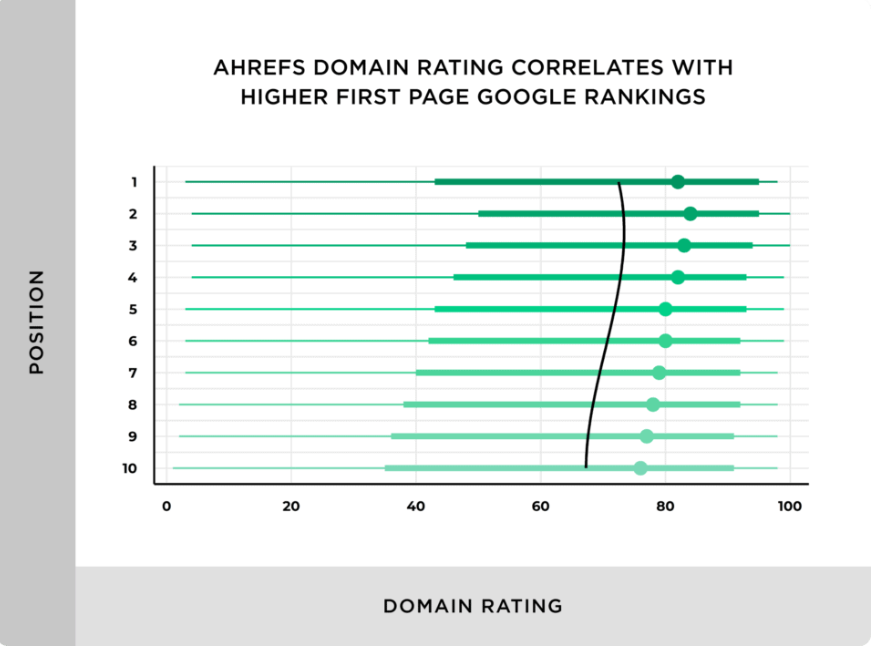 And in general, average Domain Rating increases by SERP position.
And in general, average Domain Rating increases by SERP position.
Link Building
What is Link Building?
Link building is the process of getting other websites to link to pages on your website. Its purpose is to boost the “authority” of your pages in the eyes of Google so that these pages rank higher and bring more search traffic.
Link-Building Strategies
1. Infographics / Image Sharing
Infographics are images edited with various components whose purpose is to display all kinds of data using multiple visual media.
In a few words, they are a mixture of illustrations with text that presents organized data to explain a specific topic. There is information that is not easy to present since it is made up of a lot of data; hence, infographics allow it to be broken down.
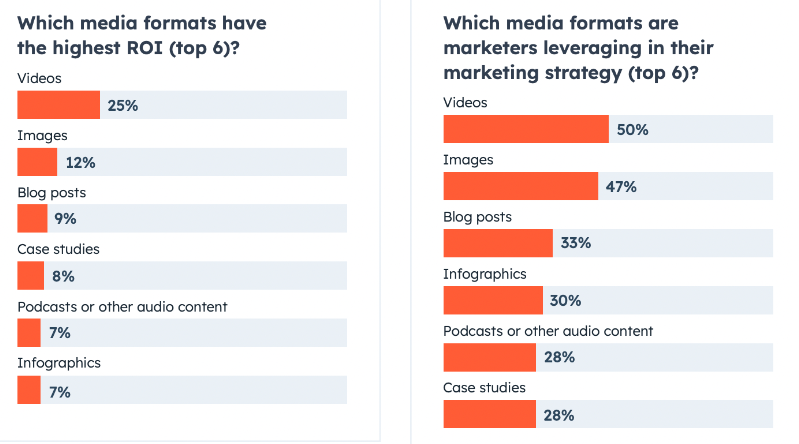
How can Infographics/Image Sharing Help in Off Page SEO?
- Enhanced Engagement and Traffic: Infographics present complex information in an easily digestible and visually appealing format, increasing user engagement and driving more traffic to your website. [Reference Blog]
- Improved Memory Retention: People are more likely to remember information presented in infographics compared to text, which can enhance brand recall and encourage repeat visits.
- Organic Backlinks: High-quality infographics are often shared and referenced by other websites, earning you valuable organic backlinks that improve your site's authority and ranking.
- Better Rankings in Image Search: Infographics can improve your chances of ranking well in image search results, providing an additional avenue for driving traffic.
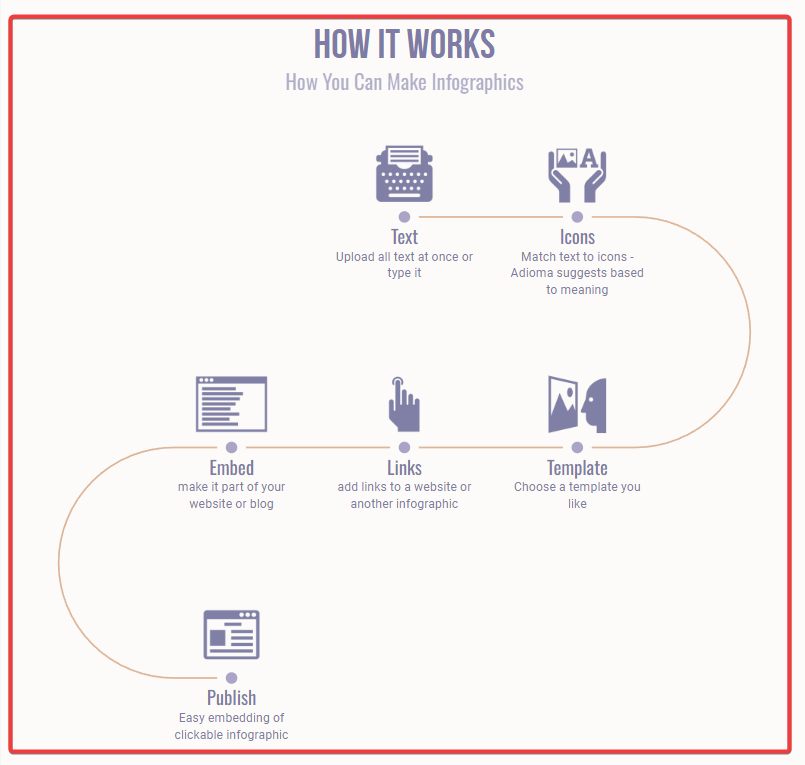
How to Build Links With Infographics/Image Sharing
- Create a High-Quality Infographic / Image: Choose a relevant topic and design an engaging, informative infographic with accurate data and appealing visuals.
- Publish the Infographic / Image: Post the infographic on your website along with a detailed blog post explaining the data and insights.
- Promote the Infographic / Image: Share it on social media, email newsletters, and online communities.
- Submit to Infographic / Image Directories: Submit your infographic to popular infographic directories to increase visibility and attract backlinks.
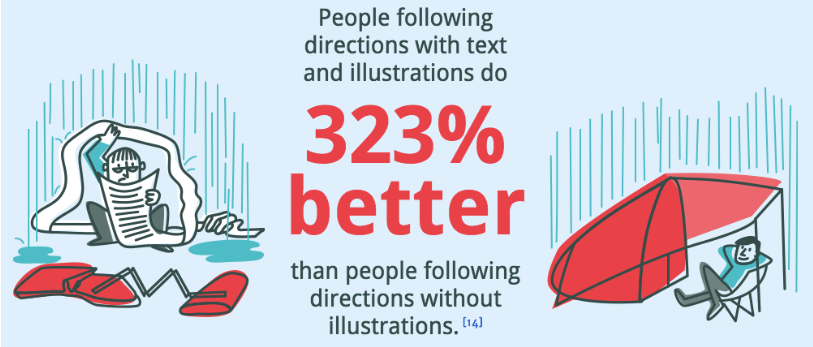
Examples of Top Infographics / Image Sharing Sites
To know More on Infographics visit neomam.com
2. Guest Blogging
Guest posting (or guest blogging) is a marketing tactic that involves writing articles for other websites in order to promote your brand.
How can Guest Posting Help in Off Page SEO?
- Boost search engine rankings
- Increase website traffic
- Generate qualified leads
- Establish brand authority
- Provide networking opportunities
To Read More Visit Mailchimp Guest Posting for SEO Blog
According to a study by SEMRush, 53% of digital marketing specialists say that guest blogging (or guest posting) is the most effective way to build a backlink profile.
A similar link-building study published by Aira in 2020 showed that guest blogging is the 3rd most effective way to build backlinks— 51% of respondents said they use it.
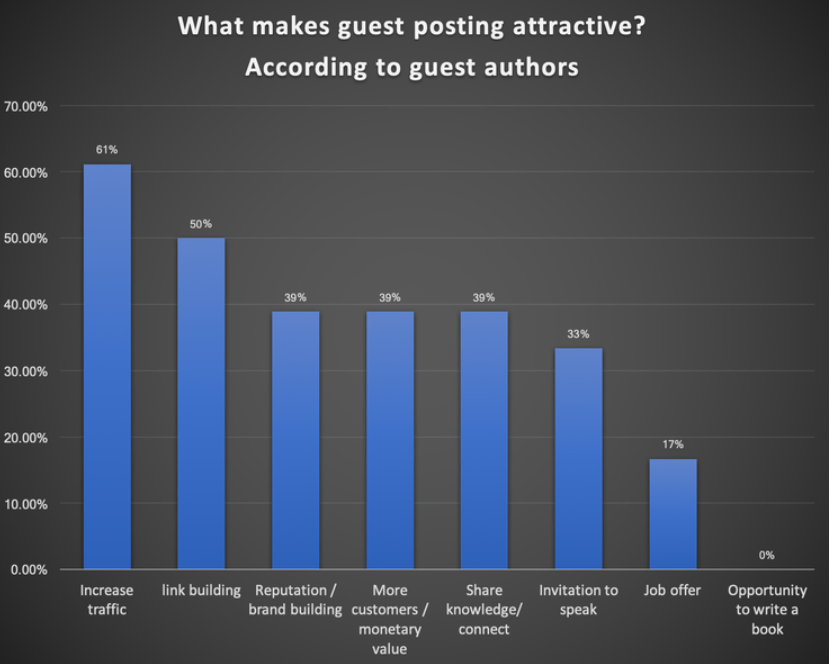
How to Build Links With Guest Posting
- Identify Relevant Blogs: Find blogs and websites in your niche that accept guest posts by searching terms like "guest post by" or "write for us"
- Research Guidelines: Review the guest posting guidelines of each site to understand their content requirements and submission process.
- Pitch Unique Ideas: Submit unique and valuable content ideas to the blog editors, highlighting how your post can benefit their audience.
- Write High-Quality Content: Create well-researched, engaging content that includes a natural link back to your site. Ensure your guest post is divided into clear sections and provides actionable insights.
- Promote Your Post: Once published, promote your guest post on social media and other channels to drive traffic and increase visibility.

Examples of Guest Posting Sites
3. Skyscraper Technique:
The SEO skyscraper technique is a link building method that involves creating content superior to current high-ranking pieces to obtain their backlinks and outrank them in the search engine results pages (SERPs).
Think of the existing high-ranking content as the tallest skyscraper. You're trying to create new content that provides even more value to rank even higher.
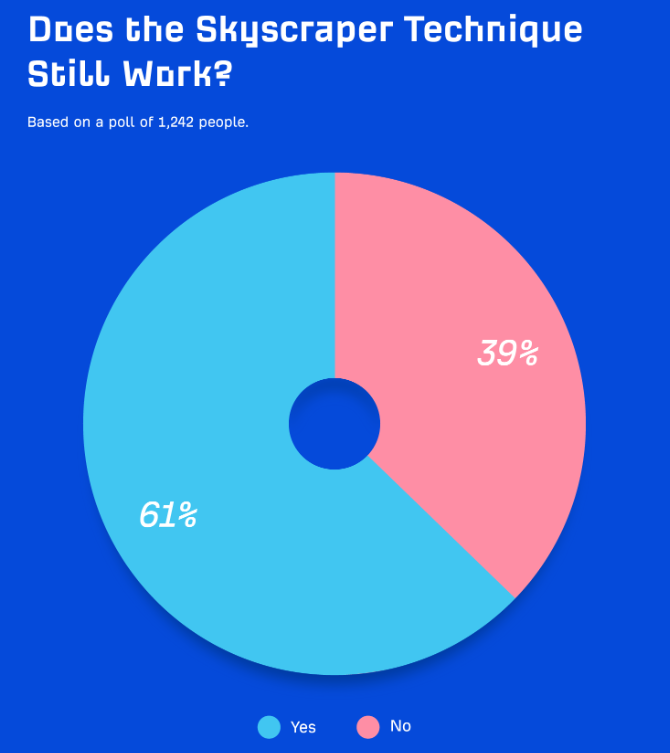
The Process can be Summarized in Three Steps:
Step 1: Find relevant, top-ranking content that has a high number of backlinks (referring domains).
Step 2: One-up the existing content with new information, research, or visuals that provide further value to readers.
Step 3: Perform email outreach to secure backlinks to your new content rather than the original content.

The Benefits of Skyscraper Content
The skyscraper technique helps you save time in your content creation process by crowd-sourcing certain content to uncover how intents are addressed and how the content is presented.
Remember that a key component of the skyscraper method is out-doing the existing content, which means that another benefit of this technique is that you provide optimal value to users.
If you can optimize for the end users’ search experiences, you can also earn organic search traffic (and push prospects down the sales funnel).
And of course, this methodology works to earn a high number of backlinks to your authoritative content (hopefully the most authoritative content there is on the topic!) which increases your site’s overall authority.
To learn more on How to do Skyscraper Technique read SEO clarity Skyscraper Technique Blog
Web 2.0
Web 2.0 refers to publisher sites that allow users to create their pages with a unique URL. For instance, social media platforms are a common type of Web 2.0 sites you'd find across the web, but they are far from the only ones. Video-sharing platforms or social bookmarking sites also fit into this category.
How can Web 2.0 Help in Off Page SEO
- Diverse Backlink Opportunities: Web 2.0 sites offer various platforms to create content and generate quality backlinks to your main website.
- Increased Online Visibility: Regularly posting on Web 2.0 sites can improve your brand's overall online presence and visibility in search results.
- Content Syndication: Web 2.0 sites allow for easy content repurposing and syndication, extending the reach of your original content.
- Authority Building: Consistently providing valuable content on Web 2.0 platforms can help establish your brand as an authority in your niche.
To know more about Web 2.0 read fastercapital Web 2.0 Sites and Their Role in Off Page SEO
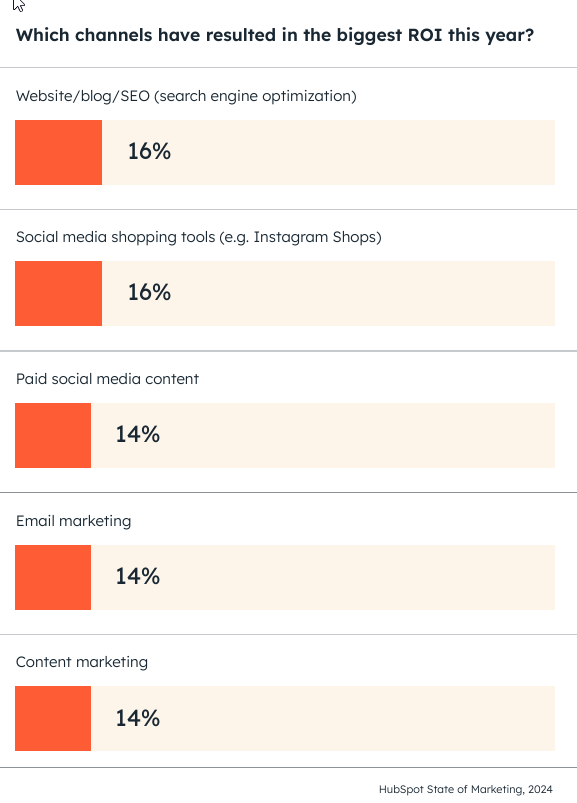
How to Build Links with Web 2.0
Select and sign up for multiple Web 2.0 platforms: Choose 5-10 reputable Web 2.0 sites to create accounts.
Create high-quality, niche-relevant content: Develop valuable articles or blog posts of at least 1600 words that align with your website's topic.
Set up your Web 2.0 blogs: Establish blogs on each platform, including About and Contact pages for credibility.
Implement strategic linking: Incorporate natural, contextual backlinks to your main website within the content.
Maintain and update regularly: Consistently add new content and engage with the platform's community to build authority and improve link effectiveness.
Examples of Web 2.0 Sites
Classified Ads
Classified submission refers to the practice of submitting your website’s details, including URL, description, and relevant information, to classified advertisement websites or directories. These platforms provide categories such as jobs, real estate, services, vehicles, and more, allowing users to post ads related to their offerings.
How can Classified Ads help in Off Page SEO
1. Improve Keyword Rankings: By strategically using keywords in your classified ads, you can help boost your website's ranking for specific search terms.
2. Cost-Effective Strategy: Many classified ad platforms are free or low-cost, making them an accessible and budget-friendly option for businesses of all sizes to improve their off-page SEO.
How to Build Links with Classified Ads
- Create Effective Classified Ads: Develop ads with a compelling headline, informative body, and clear contact details. Include relevant keywords to boost SEO.
- Choose the Right Platforms: Select reputable classified ad websites that are relevant to your niche. Consider creating your classified website to have more control over link placement.
Example of Classified Ads Sites
Other Link Building Strategies -
- Quora: A Q&A platform where users ask and answer questions. Building links on Quora can improve visibility and drive traffic to your website by providing valuable answers with relevant links.
Step-By-Step Guide To Quora Link Building
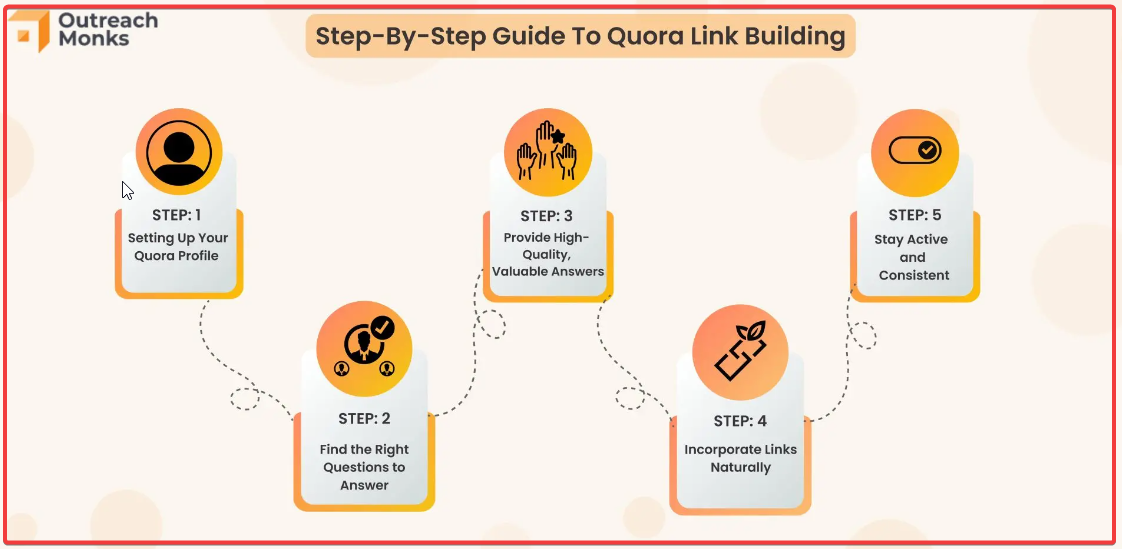
- Reddit: A social news and discussion website. Participating in relevant subreddits and sharing valuable content can help build links and increase website traffic.
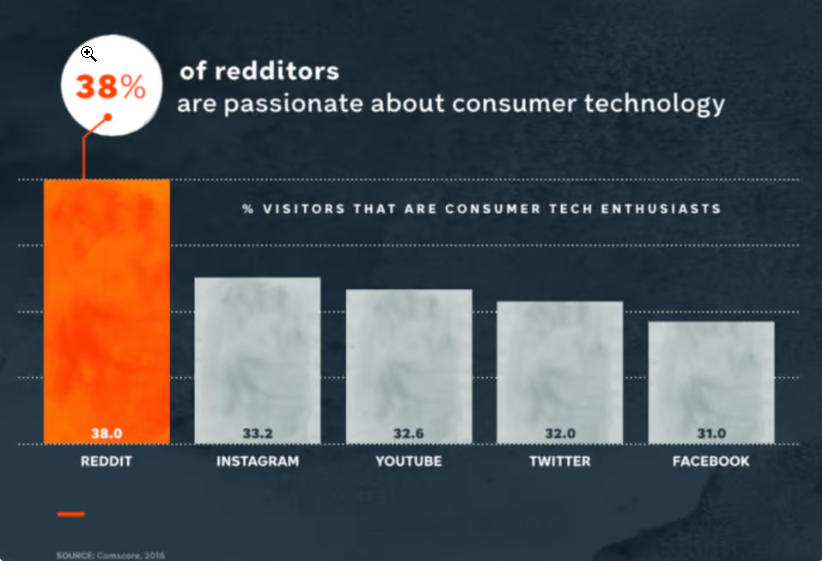
To Know More about How to Create Links on Reddit visit Prestigelinks Guide
- Blog Commenting: Engaging in thoughtful discussions on other blogs in your niche. This can help build relationships, increase visibility, and create backlinks to your site.
Know More about Blog Commenting with Searchlogistics Guide
- Facebook Groups: Communities centered around specific interests. Sharing valuable content and engaging with group members can help build authority and drive traffic to your site.
Know More about Facebook Groups Posting on socialpilot
- LinkedIn Groups: Professional networking groups focused on specific industries or topics. Participating in discussions and sharing insights can help build professional connections and drive traffic to your website.
Know More about LinkedIn Group Posting on hubspot
- Youtube: YouTube focuses on video content, offering tutorials, vlogs, and entertainment. It is a visually engaging platform suitable for detailed demonstrations and creative storytelling.
Know More about Youtube on Semrush
- Podcast: Podcasts are primarily audio-based, designed for passive listening, and ideal for multitasking. They feature in-depth discussions, interviews, or storytelling on specific topics and can be consumed while commuting, working out, or performing other tasks.
Know More about Podcast on searchengineland
Building links on these platforms can improve SEO, increase visibility, and drive targeted traffic to your website.
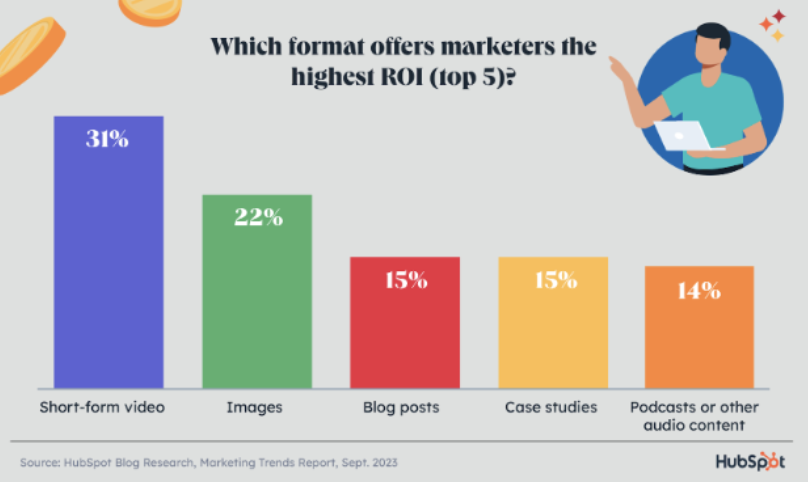
What is Brand Awareness?
Brand awareness refers to the level of familiarity consumers have with a particular brand. It is measured by how well consumers can recognize the brand's logo, name, products, and other assets.
Definition and its Role in Off-Page SEO
Branding plays a significant role in off-page SEO by enhancing a website's visibility, credibility, and authority.
Brand Awareness Strategies
Social Media Marketing
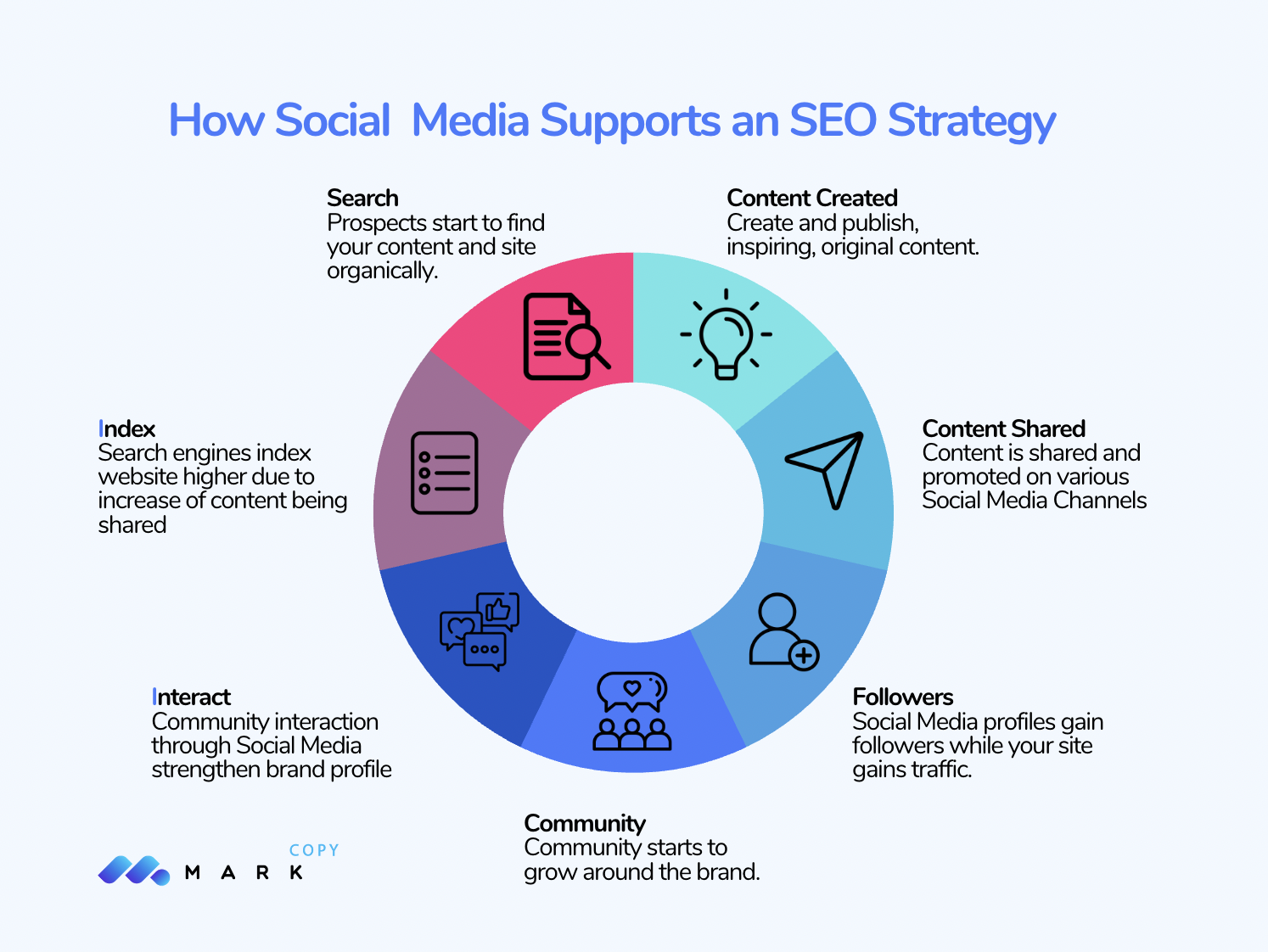
Social Media Marketing can significantly boost your brand marketing efforts in several ways:
- Increase Brand Awareness: Social media platforms provide a powerful channel to reach and engage with a large audience, enhancing brand visibility and recognition.
- Drive Engagement: Social media encourages interactions such as reposts, saves, and shares, which can amplify your brand's reach.
- Generate Leads and Boost Conversions: Effective social media marketing can help attract potential customers and guide them through the sales funnel.
- Showcase Brand Values and Story: Social media platforms allow you to create and share content that reflects your brand's values, personality, and narrative.
- Direct Communication with Customers: Social media enables real-time interaction with your audience, allowing you to respond to queries, gather feedback, and build stronger relationships.
Social Media Sources
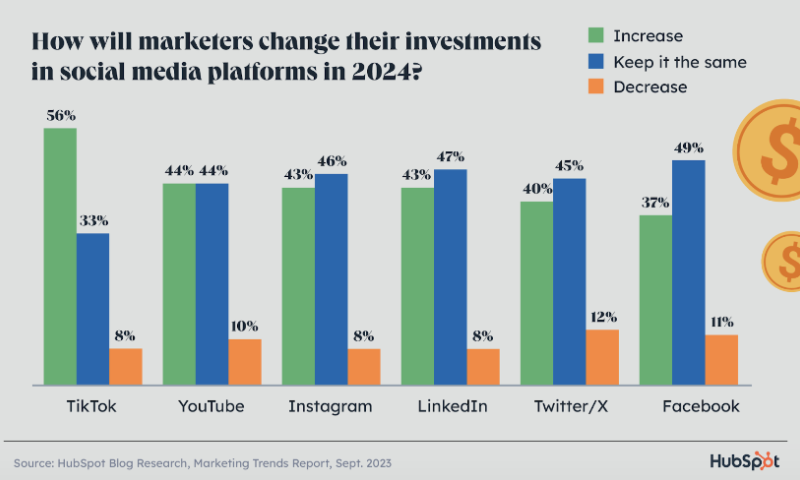
- Facebook: Large user base for wide reach
- Instagram: Visual platform ideal for showcasing products and brand identity
- Twitter: Real-time engagement and trending topics
- LinkedIn: Professional networking for B2B brands
- TikTok: Rapidly growing platform for reaching younger audiences
- YouTube: Video content for in-depth brand storytelling
- Pinterest: Pinterest is a social media platform for exploring, sharing, and storing visual content.
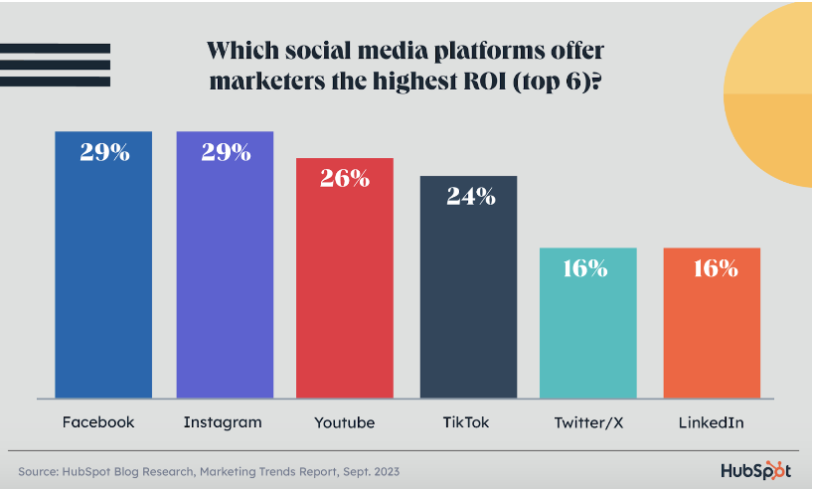
To Know more About Social Media Platforms read manypixels blog and forbes blog
Digital PR
Digital PR helps brands to appropriately communicate with their potential customers. Social media, the web, and online tools help digital PR professionals to spread the word about their brands, products, or services.
They achieve this by testing and implementing various marketing techniques and PR marketing campaigns.
What is Digital PR?
Digital PR is short for Digital Public Relations. It’s a set of marketing strategies to raise brand awareness and online presence.
The goal of digital PR is to help brands enhance their online identity and visibility. Higher social mentions, backlinks, and referral traffic are some of the main goals of digital PR.
Although it all started with Search Engine Optimization (SEO), digital PR is more than being visible and authoritative to Google. Social media marketing is another massive pillar of it.
In a nutshell, Digital PR helps you to stand out among your competitors in the online world.
3 Types of Digital PR
Now it’s time to present the three main types of digital PR:
- PR Link Building for SEO: Unlinked mentions, outreach, etc.
PR Link Building is all about using techniques based on public relations. For instance, press releases and media pitching to ensure that valuable editorial links lead back to your website.
- Social Media PR: Crisis management, influencer relations, etc.
PR crisis management includes social media actions, as part of a communication strategy. If a crisis occurs, social media PR will come to the rescue. Crises are handled by the public relations teams and social media is the tool to handle any misunderstanding.
Social media is also a great place to find influencers. Master influencer marketing to establish relationships with them and reach a wider audience.
- Press Releases: Share company news, get mentions in big publications, etc.
The digital era has affected the distribution and monitoring of news. Digital news releases are created in a way that a journalist or blogger gets all the information they need.
You can share a variety of information related to your company (contact links, images, video, etc) to optimize your digital news release to maximize web exposure.
The Future of Digital PR
The future of Digital PR is closely related to social media and that includes visual content creation with high quality based on customers’ needs.
Today’s digital PR calls for a better understanding of Business Intelligence and measuring business results.
The challenge lies in making data-driven decisions before creating a digital PR campaign with the help of data collection and optimization. That way the campaigns will be more efficient and appealing to the audience and that will lead to better PR recommendations and a greater impact.
Influencer Partnerships
Influencer partnerships represent collaborative relationships between brands and individuals with substantial online followings, known as influencers. The brands hope to leverage the influencer's reach and credibility to promote products, services, or messages to the Influencer's audience.
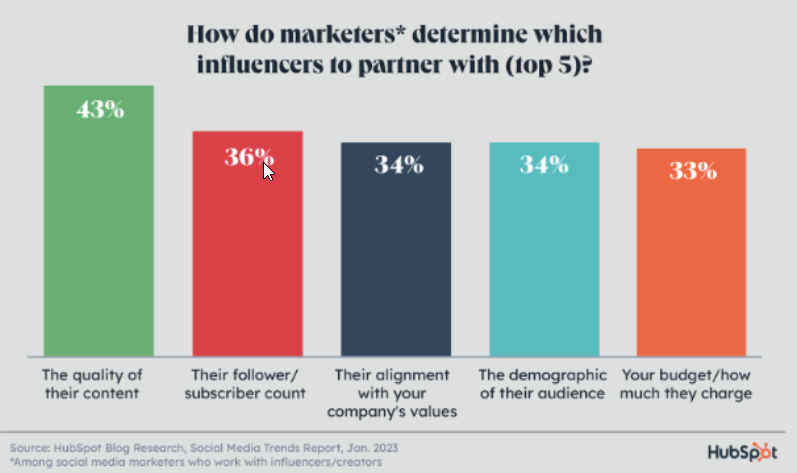
4 Benefits of Influencer Marketing
1. Influencer marketing has high ROI 1 in 4 marketers that currently leverage influencer marketing report that it offers the second highest ROI of any marketing trend, so your investments in influencer marketing won’t go to waste.
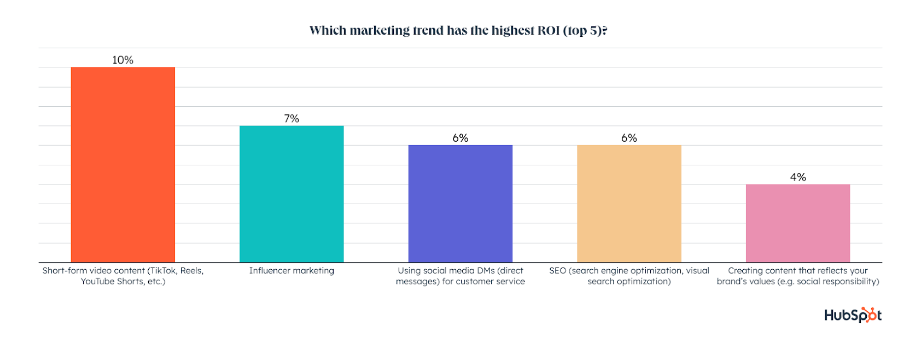
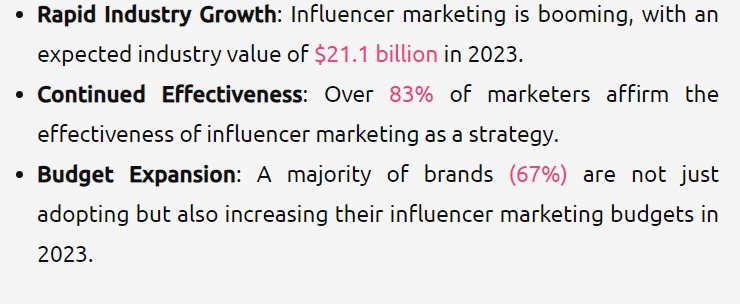
2. Influencers Help you Save Money We’ve mentioned above that influencer marketing has a high ROI, so your marketing budgets are worth something. You also have the potential to optimize your campaign budgets and see high ROI, especially when partnering with smaller micro-influencers (those with under 100k followers/subscribers).
In fact, of marketers that work with both large and small influencers, 44% say that the biggest benefit of working with small influencers is that it is less expensive.
3. Influencers Help you Establish Social Proof and Build Awareness
According to HubSpot’s 2022 Marketing Industry Trends Report, influencer marketing is the most popular and effective trend (with the highest ROI) in generating authentic content for your business, establishing social proof, and building brand awareness.
Nyst says, “Influencer marketing can be a really impactful tool for building brand awareness for your company and trust for your products or services. The power of influencer marketing lies in word-of-mouth marketing.”
They add, “Think of it this way: on the one hand, you have a brand telling you how cool it is and how its product is far superior to anything else on the market. On the other hand, you audiences have an individual who you’re already familiar with and whose opinions you trust and respect, telling you they love this brand’s product. Which are you more likely to trust?”
4. Influencers Inspire Purchases
33% of Gen Zers have bought a product based on an influencer's recommendation in the past three months, so influencers have the unique ability to drive purchases for your business, especially among your younger audiences.
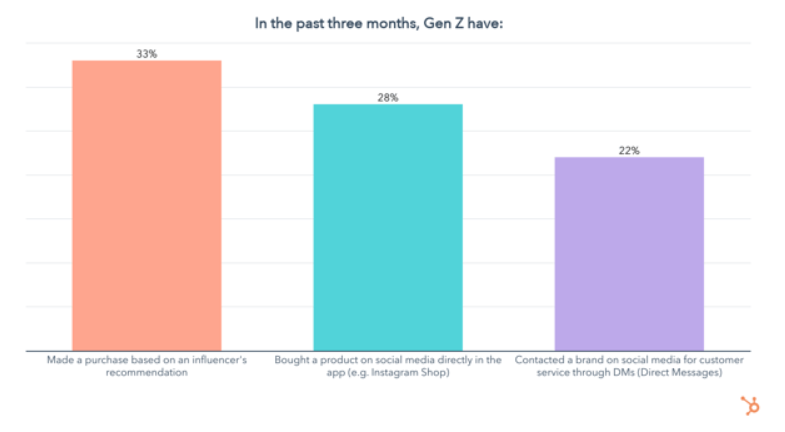
To Know More Read blog.hubspot 2024 State of Marketing & Trends Report: Data from 1400+ Global Marketers
AI Influence in Off-Page SEO
Thirty-five percent of marketers say they use AI and automation in their role, and it goes up to 54% for bloggers and SEO specialists. The question of what counts as AI or automation isn’t always clear, so usage is likely much higher. For example, Grammarly is an AI tool, but many might not yet see it that way. Speaking of, here are some of the top AI tools being used by marketers.
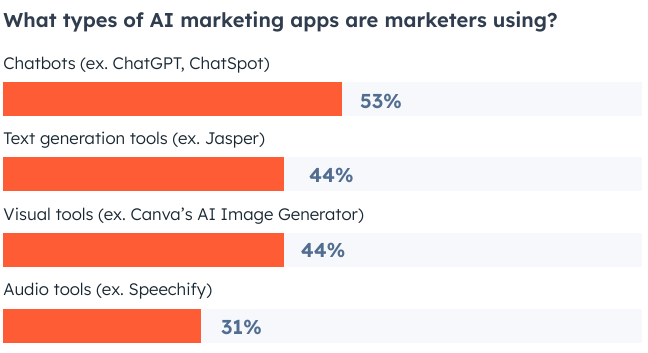
Which AI Apps are Marketers Using?
The most popular AI tool for marketing is Compose AI (18%), followed closely by Jasper (17%) and Copy.ai (16%). Here’s what some of the most popular AI tools for marketers can do.
ChatGPT - ChatGPT was Created by Open.ai, the most famous AI chatbot of them all. In just two months, ChatGPT reached 100 million users.
Jasper - Jasper is a generative AI chatbot focused on blog writing.
Google Gemini - Google Gemini is a conversational generative AI tool based on Google's LaMDA (Google's conversational AI model) that can summarize web pages, explain code, and boost productivity for any use case.
ChatSpot - HubSpot’s ChatSpot is an all-in-one AI tool for marketers: It takes all the information in a user’s HubSpot CRM and combines it with the power of ChatGPT, DALL-E 2, Stable Diffusion, and keyword research.
kive.ai - This Tool focuses largely on visuals and helps designers, brand managers, and art directors organize visual libraries and create AI-powered mood boards.
HubSpot AI Content Assistant - HubSpot’s AI Content tools include a blog writer, paragraph rewriter, email writer, and content writer. It can help you take care of creating a first draft of all your copy initiatives.
10Web AI - 10 Web AI website-building platform helps marketers and bloggers build WordPress sites at lightning speed — and helps improve UX and solve page speed issues.
SEO.ai - This tool is built to accelerate keyword research and help SEO-focused marketers do more, faster, and more effectively.
What is Local Listing
There are many ways for local businesses to increase their visibility online, but few are as effective as investing in local search engine optimization (SEO). This is because prospective customers use local search to find businesses in their area, making local SEO a great source of highly targeted traffic.
Benefits of local SEO
- Better online visibility: Local SEO activity, such as citation and link building, increases your online visibility. That makes your business more easily discoverable by new customers.
- More in-store foot traffic: Greater local visibility brings more foot traffic to your bricks-and-mortar location.
- Targeted web traffic: Optimizing your site for local search delivers more targeted traffic to your website which can lead to more leads, subscriptions, sign-ups, and sales.
- More calls: Google Business Profile (formerly known as Google My Business) optimization can lead to enhanced Google Maps visibility. This can lead to more calls and more in-person visits.
- Enhanced trust levels: Reputation management builds trust in your business.
- Improved conversion rate: Website optimization can bolster your conversion rate, increasing contact form submissions, phone calls, email subscriptions, or sales.
Why is Local SEO Important?
- 46% of all searches in Google have “local intent” (Search Engine Roundtable).
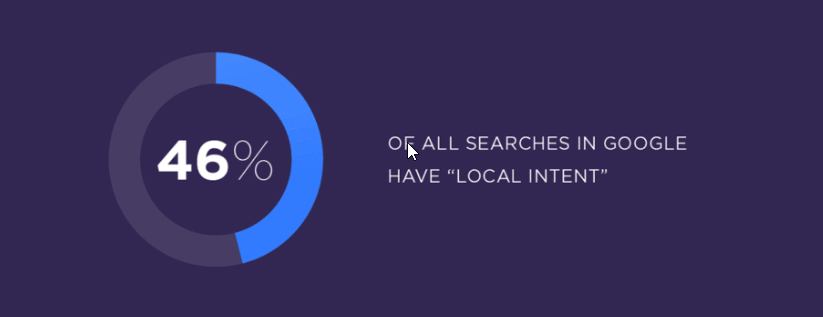
- 29% of all Google SERPs contain a local pack in the results (RankRanger).
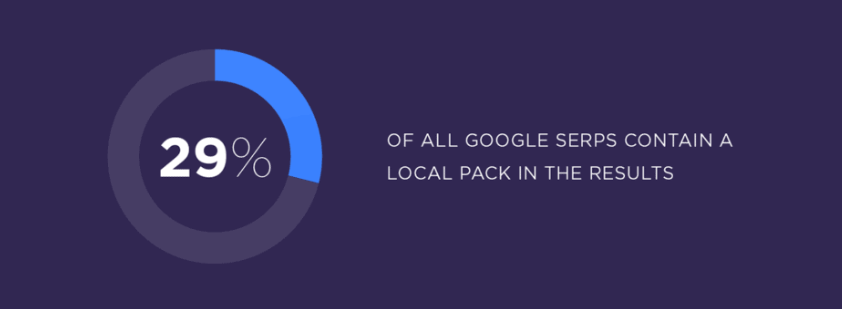
- 76% of consumers that search for something local on their phone visit a store that day (Google).
How Does Local SEO Work?
At a high-level Local SEO works like “normal” Google search.
When someone does a search, Google scans through its index to provide the best results for that person’s query.
What makes Local SEO unique is that Google uses a different set of ranking factors to rank the local search results.
In fact, local SEO has a set of unique ranking signals, including:
- The location that the person is searching from
- NAP citations
- Presence of Google Business Profile listing
- Keywords used in Google Business Profile profile
- Sentiment of online reviews
- Keywords used in online reviews
- Number of “check-ins” at that location
- Shares on social media
- Google Maps star rating for that business
Google Search Console SEO Hacks
1. Find New Content Ideas
With the help of your Google Search Console Search results report, you can find new content ideas and get an idea of the type of content that you should be creating.
By looking at the pages that are ranked in Google, you can see which content performs well in search results. This is usually a good indication of what kind of content your audience is really interested in. What kinds of topics can you branch off with?
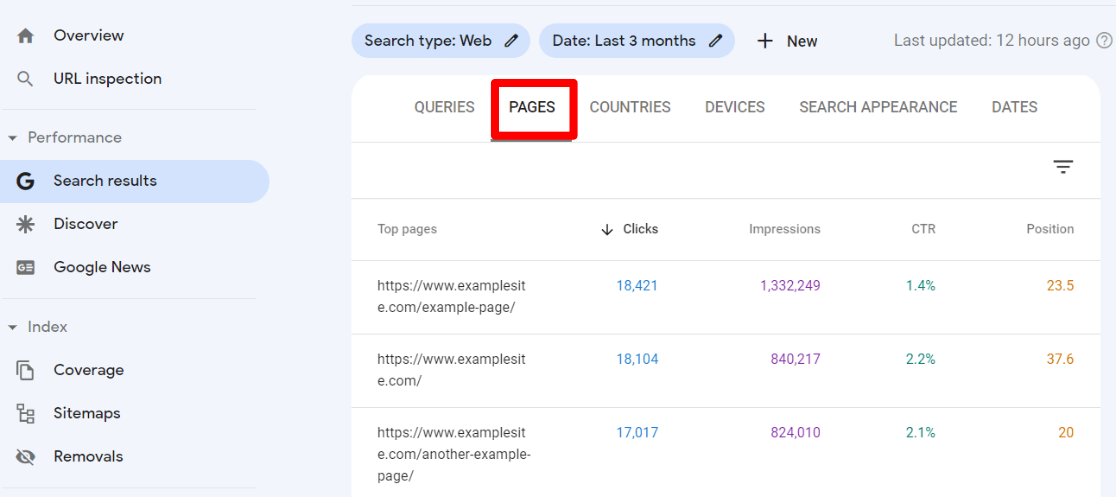
The report also helps in repurposing your content. Look at your top-performing pages and consider converting them into different types of content (infographic, podcast, slideshow, etc.) for different platforms.
2.Increase Your Rankings by Improving Internal Links
Use the Links report in Search Console can reveal a lot of valuable information. You can optimize a page you’re trying to get to rank by looking at its internal links.
In Google Search Console, go to Links (near the bottom of the navigation), and at the bottom of the Internal Links box on the right, select More.
It will then show you the pages with the most internal links on your site. Click on the filter icon, select Target page, and enter the URL of the page you want to improve.

You can then see the number of internal links the target page has. Compare it with other pages on your site. Are blog posts with more internal links ranking higher than posts you haven’t built internal links to? If they rank higher you can use the same sites to create backlinks on.
By this we can build quality links and can rank our page well.
3.Find New Backlink Opportunities
Another way you can use Google Search Console is by finding more backlink opportunities.
Backlinks play an important role in SEO and send a positive signal to Google when it’s ranking your website. To increase the number of backlinks, view the External Links report.
To find this report, head back to Links in the navigation and click the More link at the bottom of the Top linking sites box.
To find this report, head back to Links in the navigation and click the More link at the bottom of the Top linking sites box.

It will show you a list of domains that link to your site. These domains might give you another backlink since they’ve done so previously. To see the specific links you have from a domain, click on it to get the list.
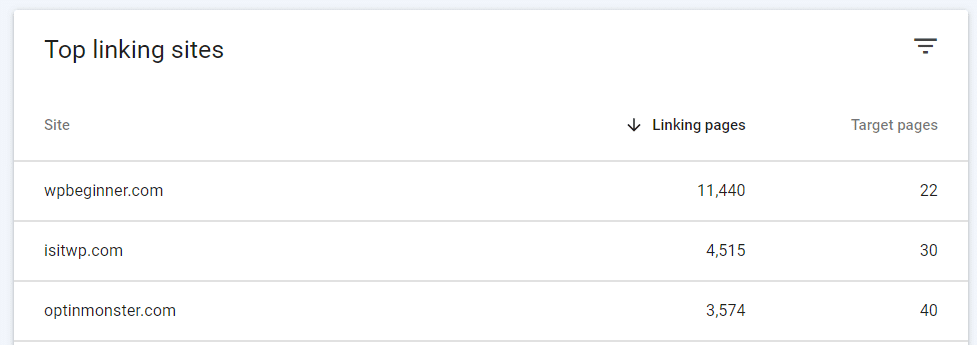
So, to ask for new backlinks, go through the top external linking websites in your report, look at the content that you think is relevant for your page, and then reach out. You can send a direct email, contact the author/editor, or use their contact form.
You can also check out other interesting ways of sending effective outreach emails.
What is SiteMap
A sitemap is a blueprint of your website that help search engines find, crawl and index all of your website’s content. Sitemaps also tell search engines which pages on your site are most important.
But before I go further, you must know that there are two types of sitemap formats: HTML and XML. Here's the basic difference:
- HTML SiteMap: This is more like your content sitemap that users can see and use to navigate your site. They're also commonly referred to as your "website archive."
- XML SiteMap: This is the sitemap that's purely used for indexing and crawling your website and is manually submitted. It's the more modern form of handling how all your content is stored across your website.
While HTML sitemaps might help users find pages on your site, as , your internal linking should take care of that anyways. So the focus from an SEO perspective should be on XML sitemaps.
There are four main types of sitemaps:
- Normal XML Sitemap: This by far the most common type of sitemap. It’s usually in the form of an XML Sitemap that links to different pages on your website.
- Video Sitemap: Used specifically to help Google understand video content on your page.
- News Sitemap: Helps Google find content on sites that are approved for Google News.
- Image Sitemap: Helps Google find all of the images hosted on your site.
Read: The 8 Best Sitemap Generator Tools
Why are Sitemaps Important?
Search engines like Google, Yahoo and Bing use sitemap to find different pages on your site.
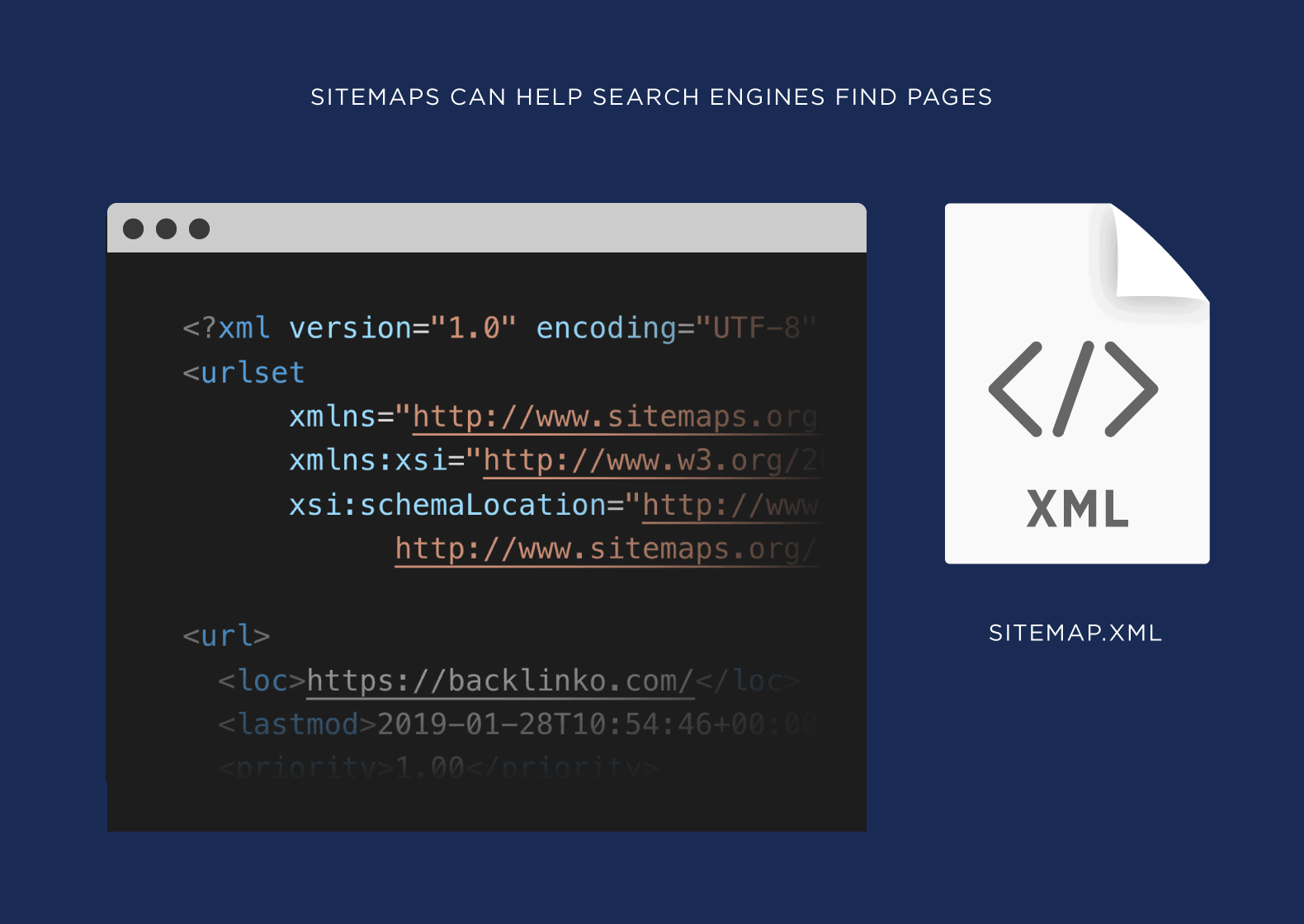
“If your site’s pages are properly linked, our web crawlers can usually discover most of your site.”
In other words: you probably don’t NEED a sitemap. But it definitely won’t hurt your SEO efforts. So it makes sense to use them.
There are also a few special cases where a sitemap really comes in handy.
For example, Google largely finds webpages through links. And if your site is brand new and only has a handful external backlinks, then a sitemap is HUGE for helping Google find pages on your site.
Or maybe you run an ecommerce site with 5 million pages. Unless you internal link PERFECTLY and have a ton of external links, Google’s going to have a tough time finding all of those pages. That’s where sitemaps come in.
Search engines like Google, Yahoo and Bing use your sitemap to find different pages on your site.
“If your site’s pages are properly linked, our web crawlers can usually discover most of your site.”
In other words: you probably don’t NEED a sitemap. But it definitely won’t hurt your SEO efforts. So it makes sense to use them.
There are also a few special cases where a sitemap really comes in handy.
For example, Google largely finds webpages through links. And if your site is brand new and only has a handful external backlinks, then a sitemap is HUGE for helping Google find pages on your site.
Or maybe you run an ecommerce site with 5 million pages. Unless you internal link PERFECTLY and have a ton of external links, Google’s going to have a tough time finding all of those pages. That’s where sitemaps come in.
With that, here’s how to setup a sitemap…and optimize it for SEO.
What Are Push Notifications?
Push notifications are clickable pop-up messages that appear on your users’ browsers irrespective of the device they’re using or the browser they’re on. They serve as a quick communication channel enabling companies to convey messages, offers, or other information to their customers. Subscribers can be anywhere on the browser and still receive these messages as long as they’re online or have their browsers running on their devices.
Different types of push notifications
Ideally, there are four types of push notifications – Web push notifications, Desktop push notifications, Mobile app push notifications, and push notifications for wearables Let’s learn about them in some detail:
1. Web Push Notification:
Web push notifications are messages sent to a user's desktop or mobile web browser to increase engagement and encourage visitors to return to a website, ultimately boosting conversions. They can be set up easily and are a handy tool for marketers.
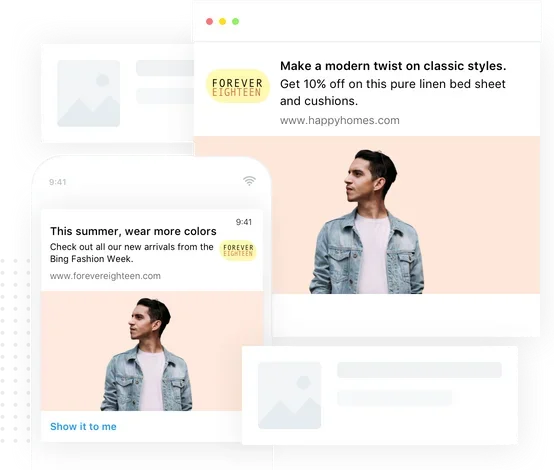
2. Desktop Push Notifications:
Unlike web push notifications, desktop push notifications appear only on your users’ desktops. These notifications are driven mainly by the products that you have installed on your desktop, with the aim of driving customer engagement. Desktop push notifications are fairly difficult to build as compared to web push notifications and require a developer’s help as well.
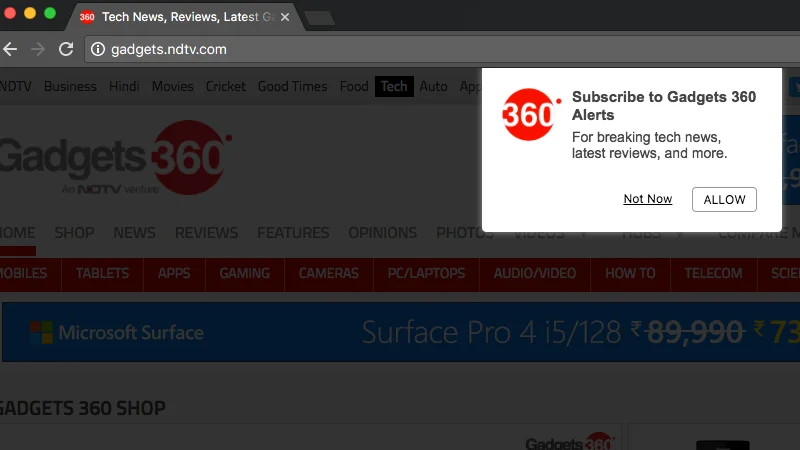
Image Source: Gadgets360
3. Mobile App Push Notifications:
Mobile app push notifications are triggered by the app on your device. Unique identifiers are registered for the app and the device with the OS push notification service. Publishers send notifications to increase customer engagement. Notifications can appear on the lock screen, banner, and notification center. Android has a default opt-in setting, while iOS requires user consent before sending notifications. Developer help is required to create mobile app push notifications.
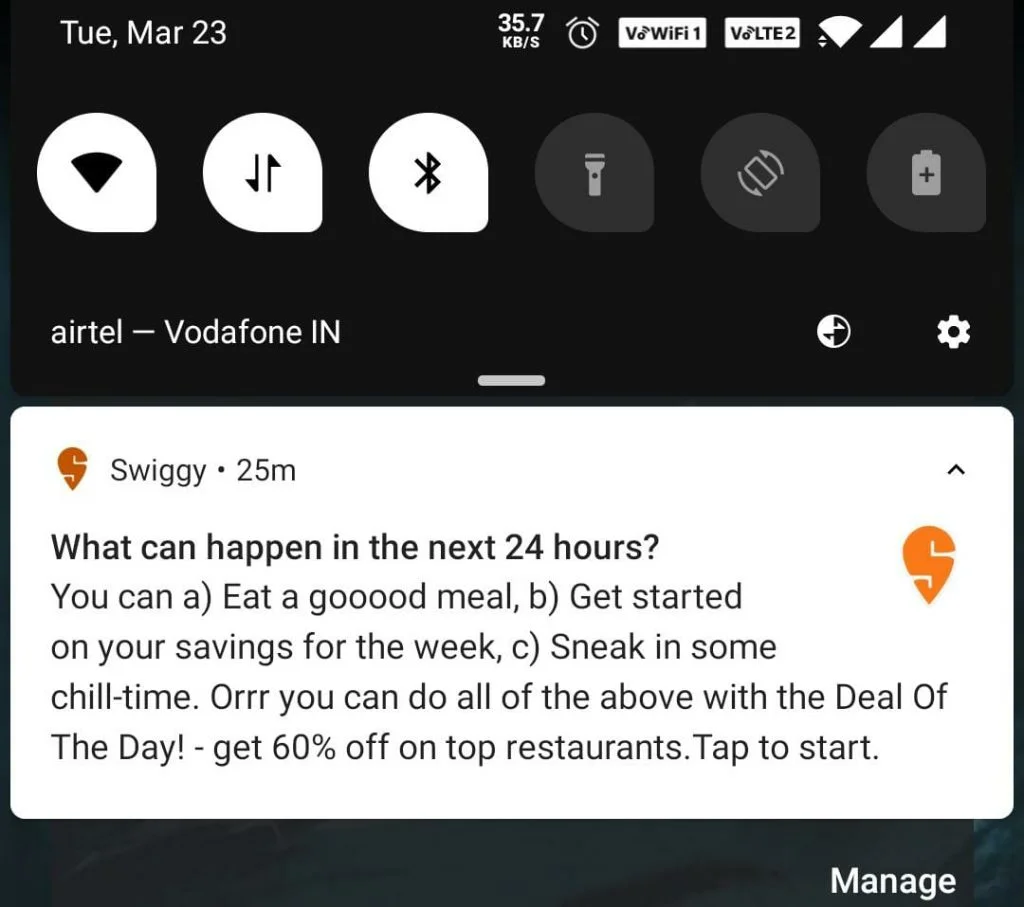
How do push notifications work?
- Opt-in by User: The process begins when a user opts in to receive push notifications from a specific app or website. This consent is crucial as notifications can only be sent after the user has agreed to receive them [Read More].
- Message Creation: Once a user has opted in, the app or website creates the push notification message. These messages are often small, clickable alerts designed to grab the user's attention [Read More].
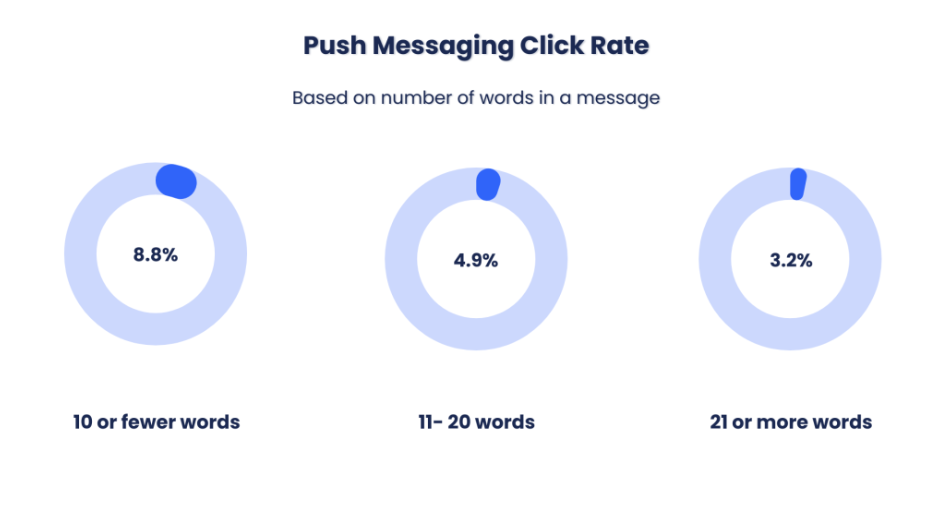
- Message Sending: The notification is sent from a trusted server or cloud service. This infrastructure ensures that the message is delivered to the right device and user [Read More].
- Message Delivery and Display: The push notification appears on the user’s device as an alert or pop-up. Users can click on these notifications to be directed to specific content within the app or website [Read More].
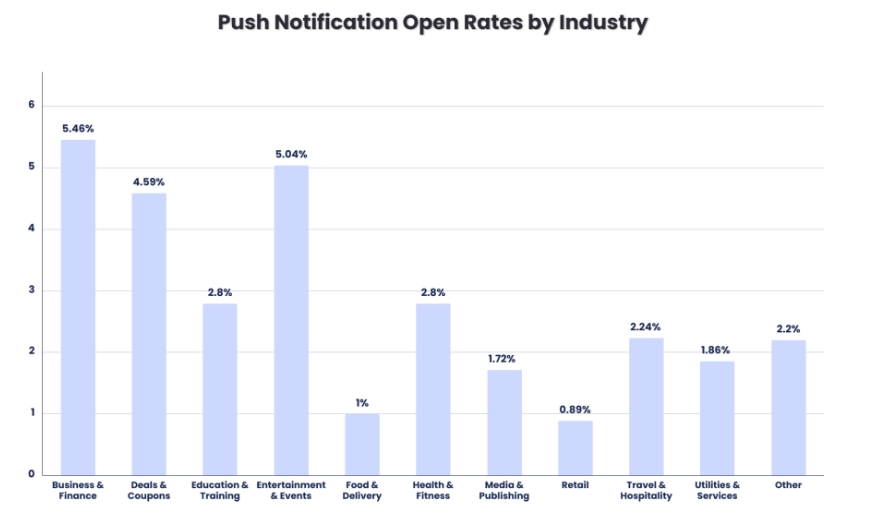
What is multilingual content marketing, and why is it so important?
Multilingual content marketing involves creating content in various languages.
It’s trickier than it sounds, as it involves more than simply translating the content from your primary marketing language.
The main aim of content marketing is to build trust with your audience and to do that, you need to speak their language and understand their cultural references. This is why multilingual content marketing involves not only translating content but also localizing it to each region.
A big part of your multilingual content strategy should be focused on creating content that is relevant to each market. This requires research and a native understanding of the local language and culture.
Why is this so important?
Simply translating and localizing your content into even one other language is a giant step toward maximizing your online reach.
Fact: The internet is home to 204 million Spanish speakers, with a combined spending power of $3.5 trillion. ¡Olé!
English used to dominate the internet, but those days are gone. And businesses that aren’t translating their online content are leaving a lot of money on the table. Simply put, if you want to reach an international audience, you need to speak their language.
Tool To convert content to Multilingual Language - Google Translate
To Know More Visit - https://debutify.com/blog/multilingual-content-marketing/
Conclusion
If we implement all these techniques we will be able to rank well on google that will help us to bring leads and good traffic.
Off-Page SEO Techniques for Toolstation
After conducting over 10 days of research, we have completed the off-page research task that will help Toolstation improve its ranking and increase its website traffic. The data we collected comes from trusted sources, and we will provide a reference link for the same. After extensive research on off-page SEO, we concluded that these are the trusted strategies/techniques for off-page SEO.
- Quality Backlink Building
- Social Media Engagement
- Guest Blogging
- Online Reviews and Ratings (ORM)
- Directory Listings
- Google My Business Optimization
We have given the details below:
1. Quality Backlink Building
We have completed research on various quality backlinks-building techniques like Infographics/Image Sharing, Skyscraper Technique, Web 2.0, Classified Ads, Local Listing, etc, along with their reference sites so that we can improve the ranking by building links on these sites.
2. Social Media Engagement
We have researched how social media will boost the traffic of Toolstation. From our research, we have decided to post regularly on Toolstation's social media accounts to make sure that all people are regularly updated with all our offers and promotions. Increased engagement on social media platforms, drives good traffic to the website and improves brand awareness.
3. Guest Blogging
We have done research and identified the latest trends for guest blogging. Based on these latest trends, we’ll compile a list of high-authority blogs and websites in our niche and then we’ll engage with blog owners and editors through social media and email to build relationships and increase the chances of guest post-acceptance for Toolstation. This approach will help in reaching a wider audience and establishing authority in the industry.
4. Online Reviews and Ratings (ORM)
We researched the best way we can work on ORM to show our customers that their reviews matter. The SEO team will keep track of all the new reviews being posted on different reviews and rating platforms and will give the required response for the same.
5. Directory Listings
Our research helped us to know that to enhance visibility in local search results we need to create a well-maintained business profile on all the platforms like Yelp. From this, we can easily attract local customers and improve Toolstation brand awareness.
6. Google My Business Optimization
This month we have researched GMB, and we analyzed the more we focus on optimizing Google My Business (GMB) as part of the off-page SEO strategy it will help us to increase the local search visibility and attract more local customers. This strategy will directly improve the ranking.
Benefits
- Enhanced Visibility and Traffic: If we implement all these strategies we will be able to boost our ranking and traffic at the same time.
- Brand Authority and Trust: Quality backlinks and positive reviews build brand credibility and authority.
- Local Engagement: Optimized local SEO strategies help attract local customers and drive in-store traffic.